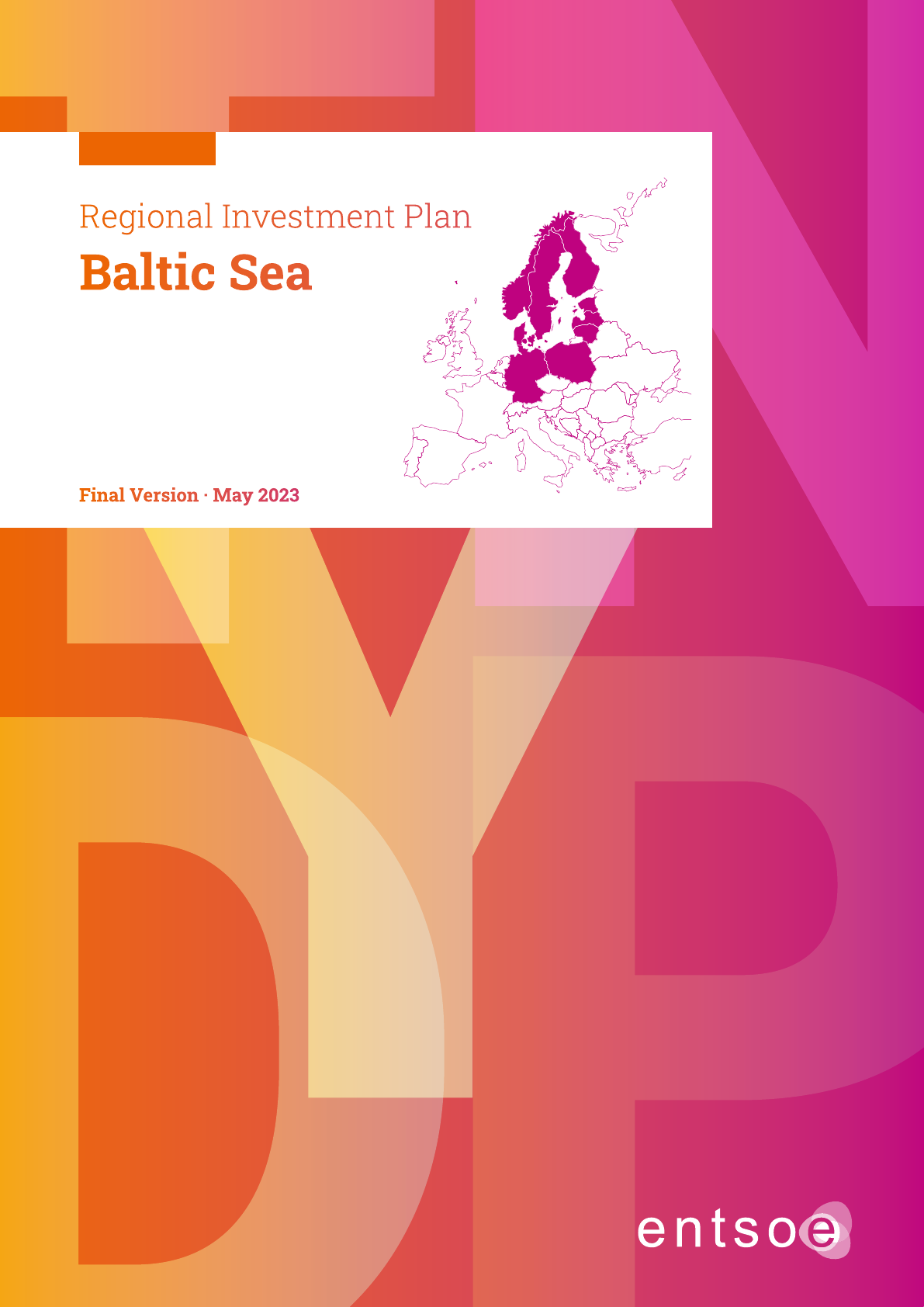
Regional Investment Plan
Baltic Sea
TYNDP 2022
Final Version · May 2023
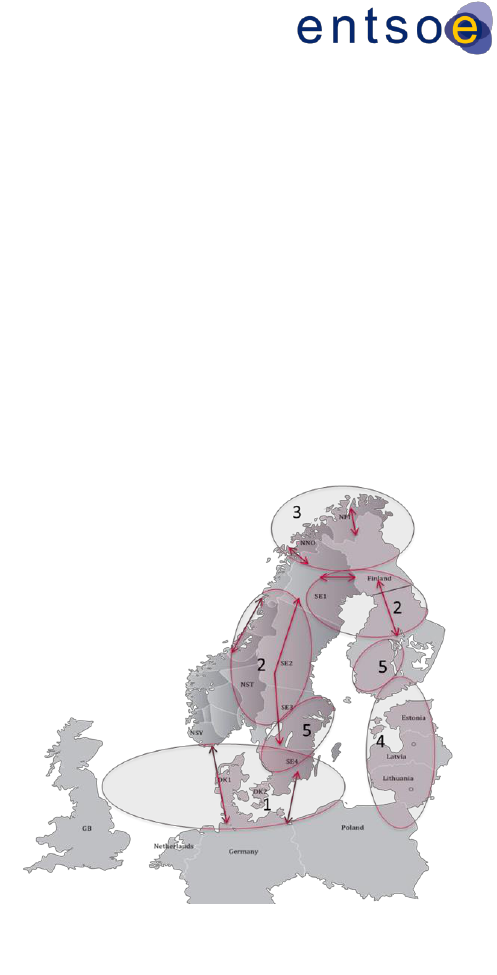
Regional Investment Plan 2022 – Baltic Sea
1
1. EXECUTIVE SUMMARY – Key messages of the region
The electricity system in the Baltic Sea region is undergoing significant changes as the
electricity generation structure is rapidly decarbonising and production is becoming more variable
due to weather conditions. The development of renewable energy in the region has been accelerated
by rapid technological advances and national subsidies. The energy transition is producing more
renewables and lessening the region’s reliance on thermal power plants. These developments have
reduced carbon dioxide emissions but also increased the risk of brownouts or blackouts in parts of
the region, as identified in the ERAA 2021. Simultaneously, society’s dependency on electricity is
increasing. As a result, the power systems of the future will be expected to provide even greater
reliability to safeguard the vital functioning of society.
Large quantities of new renewable
energy generation are still being planned
across the region, and these must be
integrated successfully, while also maintaining
the security of supply and facilitating an
efficient and secure European energy market.
The integration of renewables will further
replace production from thermal power plants.
The grid needs to facilitate flows to cover the
deficit at load centres caused by the closure of
power plants and the growing flows between
synchronous areas. To solve the challenges of
load balancing and power generation – in all
parts of the region – further grid development
is necessary, and the prospects for such
development are favourable. As the future
generation mix is expected to be far more
weather dependent, this increases the need to
strengthen the grid.
The main driver for the energy system
in the region is the green energy transition, followed by climate and decarbonisation goals. From a
grid development perspective, the most important drivers within the Baltic Sea region are as follows:
Driver 0: Rapid expansion of offshore wind → Offshore infrastructure needed
The Baltic Sea area has great potential for offshore wind development due to shallow waters
and good wind conditions. The political goals of the European Union (300 GW by 2050), combined
with these good offshore wind prospects, have resulted in huge ambitions for most of the countries
around the Baltic Sea. However, the potential for energy generation may be greater than the
consumption needs. Hence a planned and coordinated offshore wind development might be wise.
Good coordination between the countries around the Baltic Sea in the development of the offshore
infrastructure would probably be very valuable. The rapid expansion of offshore and onshore
infrastructure is required to integrate this energy source into the system and deliver the energy to
the main demand centres. Both Member States and TSOs of the Baltic Sea region have started
Figure 1-1: Key drivers of the Baltic Sea region

Regional Investment Plan 2022 – Baltic Sea
2
forming the first cooperation platforms. This also meets the requirements of the new TEN-E
regulation, which asks ENTSO-E to publish offshore grid development plans for 5 sea basins,
including the Baltic Sea area, at the beginning of 2024.
Driver 1: Need for flexibility → Further integration between synchronous areas
The transformation of the European power system is leading to a less flexible generation mix.
However, the Nordic system will continue to be relatively flexible due to its hydro-dominated
generation mix. In addition, the Nordic system is likely to increase its annual energy surplus, though
some nuclear power plants have been decommissioned. Both the need for flexibility and the
expected price differences between the systems will be drivers for the further integration of
synchronous systems. In continental low wind situations, energy might be exported from the Nordic
system, whereas in continental high wind situations power might be imported and stored in the hydro-
dominated Nordic system. Hybrid solutions may also integrate offshore wind energy.
Driver 2: Integration of onshore renewables → Increased North-South flows
Based on the political goals of reduced CO2 emissions and the cost development of wind
and solar generation units, further integration of onshore renewables is expected within the Nordic
countries. In Germany, large amounts of solar energy are already being produced and further
increases are expected. In Germany, Denmark and Sweden, large amounts of onshore wind energy
are already integrated. New interconnectors to the continent/Baltic States, in combination with
substantial amounts of new renewable generation capacity, are increasing the need to strengthen
north-south transmission capacities in Germany, Sweden, Norway, Finland and Denmark. In
addition, plans for the decommission of nuclear and/or thermal plants in southern Germany, Sweden,
Denmark and Finland will further increase capacity need in the north-south direction. One exception
might be the greenification of the north Swedish steel industry, which might decrease the need for
north-south transport through Sweden in the long run. In the Baltic States, plans for the development
of onshore wind generation are increasing dramatically. In the last couple of years, TSOs has issued
the technical requirements for onshore wind connection up to 10 GW of installed capacity.
Driver 3: Electrification/new consumption → Reinforcing the grid
To meet the EU climate goals, the European energy system must become much more
efficient. This will demand the more efficient use of energy in industry, transport and households, as
well as solutions for lowering energy consumption. As a result, the total energy demand for Europe
should decrease. Electrification of all kinds of consumption will play a major role in this transformation
to a much more efficient and decarbonised system. In addition, new types of consumption, such as
data storage, will increase electricity consumption. Over the coming decades, energy consumption
is expected to decrease, while electricity consumption is expected to increase. This increased
electricity consumption and electrification will therefore mean huge reinforcements of the grid might
be necessary.
Driver 4: Baltic integration - Improved security of supply for the Baltic system
For historical reasons, the electricity systems of the Baltic States currently operate
synchronously with the Russian and Belarussian electricity systems (the IPS/UPS system). In recent
years, great progress has been made in integrating the Baltic countries with the European energy

Regional Investment Plan 2022 – Baltic Sea
3
markets. The Baltic countries are now connected to Finland, Sweden and Poland via HVDC
connections.
The three Baltic TSOs are now preparing to de-synchronise from IPS/UPS and instead
synchronise with the Continental European Network (CEN) through the existing interconnection
between Lithuania and Poland. In addition, a new subsea HVDC (the Harmony Link) is planned
between Lithuania and Poland, aimed at improving the security of supply. Synchronising the Baltic
countries with the CEN will ensure energy security by their connection to a grid that is operated using
joint European rules. As a result of the Ukrainian conflict, work on the project is accelerating, which
means that the Baltic system can decouple from Russia and Belarus at any time.
Driver 5: Nuclear and thermal decommissioning → Security of supply challenges
All of the nuclear power plants in Germany, a substantial proportion of the thermal/nuclear
power plants in Sweden and a substantial proportion of the thermal power plants in Germany,
Denmark and Finland are expected to be decommissioned by 2030. Furthermore, the
decommissioning of thermal power plants, particularly in Poland, is needed to achieve the EU’s
climate targets. Decommissioning of both the nuclear and thermal power plants will system risk,
challenging the security of supply. Nuclear and thermal power are important in today’s system, and
a phaseout will require new generation capacity, grid development, and further development of
system services.
Driver 6: Smart sector integration and flexible loads → Optimising decarbonisation
Sector integration, demand response and flexible loads are core instruments for cutting
emissions cost-effectively. Smart Sector Integration (SSI) seeks the optimal solution for the whole
energy system, supporting a fast and cost-optimised path to zero emissions by 2050. Electricity
would be used directly in sectors such as transportation and industry and for heating buildings or
used indirectly to produce green hydrogen. The hydrogen can in turn be used directly for
transportation, heating, and even power generation – for example, during hours of scarcity – or to
produce methane, fuel, ammonia or more. The benefits of SSI arise from the variable character and
falling costs of wind and solar power. In addition to cutting emissions cost-effectively, SSI provides
offers the flexibility to employ various energy systems. This again increases supply security. Flexible
loads and demand response will help in the optimisation of the dimensioning and operation of the
power system. Flexibility markets may be used in the future to solve bottlenecks in the system.
Driver 7: Current geopolitical developments accelerate the transition
At this writing, Europe, like the rest of the world, is experiencing an energy crisis. Energy
carriers were already paying high prices before Russia invaded Ukraine. The Baltic Sea region is
more dependent on Russia than most other regions of Europe. The long-term effects of the current
situation are not yet known, but geopolitics and energy independence are likely to be important
themes in decision-making. Improving the security of supply in the region, accelerating the transition
to renewables, speeding the synchronisation process and diversifying power production are now
topics of discussion. To counter the current energy crisis, the European Commission has proposed
the ‘REPowerEU’ plan, which aims to reduce the usage of fossil gas by 155 billion cubic metres
(BCM) by 2030.

Regional Investment Plan 2022 – Baltic Sea
4
1.2 Future capacity needs
The drivers described above are the basis for further grid development. Short-term grid
development needs can be studied by analysing the current measurements, trends, generation plans
and expected consumption changes. Grid infrastructure is a long-term investment with a lifetime of
decades. Building a new line, for example, can take ten years or longer, particularly when factoring
in planning and permitting. Therefore, it is important to consider the benefits of new infrastructure in
the long term. It is not meaningful to try to forecast the future as ‘one truth’ because small changes,
such as in policies or fuel prices, can have major impacts.
In addition to the main drivers described above, the list below describes the key future capacity
needs for the region and the positive effects of transmission grid expansion up to 2050:
• The green energy transition, along with climate goals and decarbonisation, will lead to
fundamental changes in generation and energy demand, which will trigger changes in power
flows across the region. The dominant power flow direction will be north to south.
•
Rapid expansion of both onshore and offshore renewables in the region and the
decommissioning of nuclear power plants in Germany by the end of 2022 and potentially in
Sweden by 2040 will trigger related offshore and onshore infrastructure needs.
•
Flexibility will be challenged. Sector integration and demand response will be part of the
solution, together with hydro resources. In addition, further capacity increase between
different countries and synchronous areas might be necessary.
•
The plans described above require new interconnectors, some of which are already in
preparation, under construction or commissioned. These interconnectors will also help with
internal energy market (IEM), security of supply (SoS) and renewable energy sources (RES)
integration. Continued strong collaboration between actors in the region is needed, and those
actors are responsible for the timely implementation of interconnectors.
•
The Baltic countries will be synchronised with continental Europe by 2025 at the latest, but
the security of supply will need to be further enhanced. The medium-term SoS in the Baltic
States are primarily related to flexibility needs after desynchronisation from IPS/UPS and
synchronisation with the CEN.
All of the scenarios being studied in the Identification of System Needs (IoSN) include a large
increase in renewable generation and a decrease in CO2 emissions; but without additional grid
development, the price spread between market areas in the region would increase rapidly and some
of the climate benefits would not be realised. The benefits of increased capacities in the scenarios
are clear in Chapter 3 of this report, which describes the market results of the IoSN. Increasing
capacities at the borders would have a significant impact on both the electrical system and society.
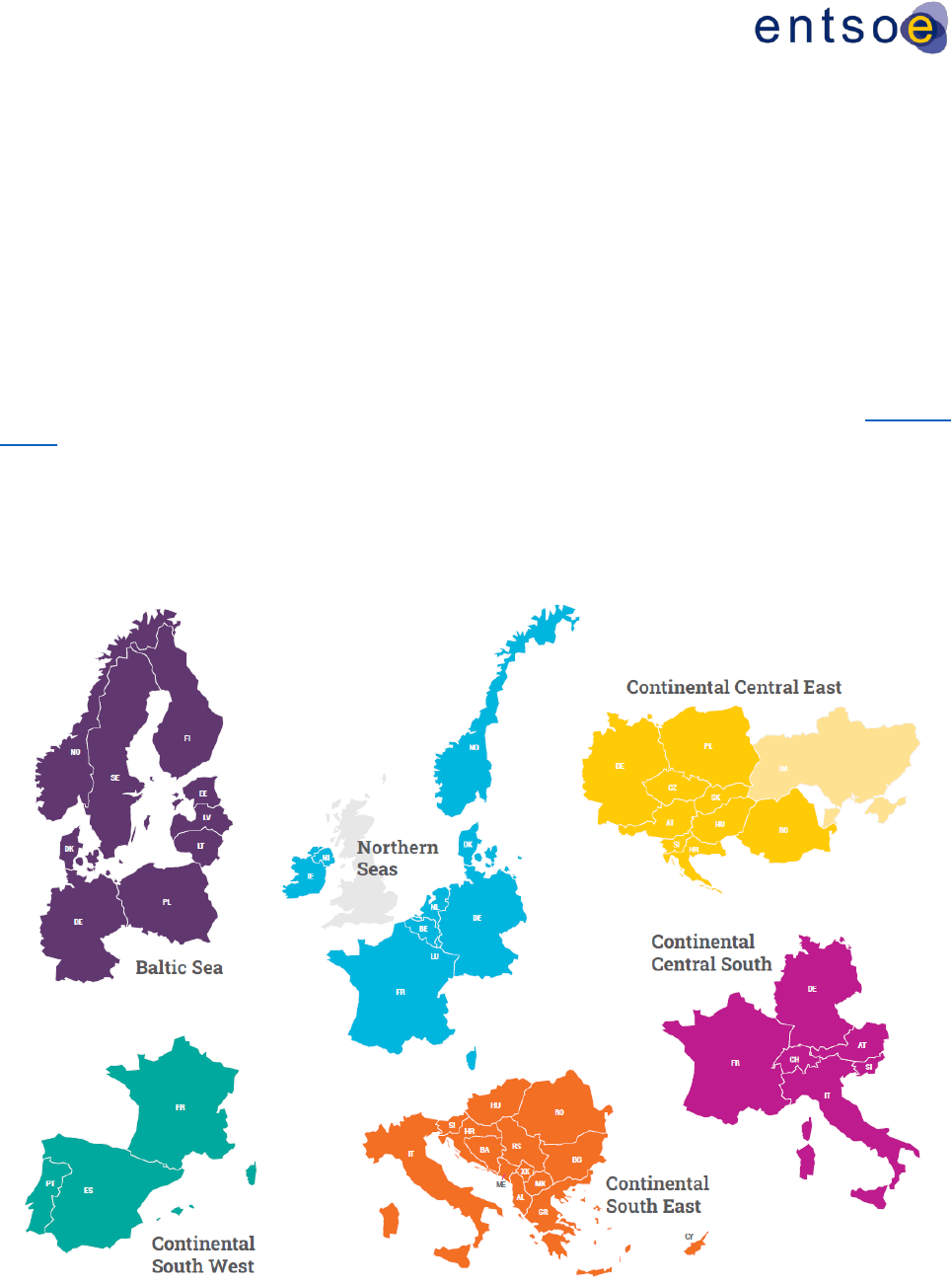
Regional Investment Plan 2022 – Baltic Sea
5
2. INTRODUCTION AND REGIONAL CONTEXT
2.1 About Regional Investment Plans
2.1.1 Legal requirements and links to the TYNDP package
The Regional Investments Plans are part of the Ten-Year Network Development Plan
(TYNDP) package and comply with Regulation (EU) 2019/943 (Article 34 and Article 48) that
requests TSOs to establish regional cooperation within ENTSO-E and publish a Regional Investment
Plan biennially. In addition, TSOs may take investment decisions based on that Plan.
Regional Investment Plans are part of the TYNDP 2022 package, which also includes the Scenario
report and the System needs study. The Scenario report describes possible European energy
futures up to 2050 and is used to test potential electricity and gas infrastructure needs and projects.
The scenarios serve as a basis for the Regional Investment Plans by describing the region’s future
challenges. The System needs study investigates system gaps in the mid- and long-term time
horizons (2030 and 2040) in the National Trends scenario. The present Plan further analyses at
regional and country levels the capacity increases identified in the System needs study.
Figure 2-1: ENTSO-E’s System Development regions. Each region is covered by one Regional Investment
Plan.

Regional Investment Plan 2022 – Baltic Sea
6
2.1.2 Scope of the RegIPs 2022
Regional investment plans describe the present situation in each region as well as future
regional challenges, considering 2030 and 2040 time horizons. The Regional Investment Plan 2022
also investigates solutions that could help to mitigate future challenges and offers projections in
terms of internal network reinforcements. In addition, this edition of the Plan includes a study
roadmap for the region, laying out ongoing and future studies that cover the priorities stemming from
the 2040 System needs analysis.
The present document comprises the following chapters:
• Chapter 1 gathers the key messages relating to the Regional Group Baltic Sea.
• Chapter 2 outlines the legal requirements and scope of the Regional Investment Plans. An
overview of the present situation of the regions is also presented.
• Chapter 3 describes the identified regional system needs, which depend on the regional
challenges.
• Chapter 4 is dedicated to additional region-specific analyses.
• Chapter 5 presents the future challenges in the region, the necessary mitigation steps and
projections based on expected internal reinforcements.
• The Appendix includes additional region-specific content and lists of the abbreviations and
terminology used in the report.

Regional Investment Plan 2022 – Baltic Sea
7
2.2 Introduction to the region
The Baltic Sea Regional Group, under the scope of the ENTSO-E System Development
Committee, is among the six regional groups that have been set up to cover short- and long-term
transmission grid planning and system development tasks. The group has been working actively
since 2010 and cooperation among the TSOs has been very good. The countries belonging to the
Baltic Sea Regional Group are shown below.
Figure 2 – 2: ENTSO-E System Development Committee Baltic Sea region
The Baltic Sea Regional Group comprises nine countries, which are listed in Table 2-1 along
with their representative TSOs. Each Member State prepares its own National Development Plan
that contains much more detailed information about the power system and transmission network
developments in that country. The national development plans are harmonised with TYNDP and are
designed in line with European Union regulations and guidelines to meet long-term targets and
strategies. Links to the national development plans of the Baltic Sea Regional Group countries are
provided below.
Country
Company/TSO
Links to the NDP
Denmark
ENERGINET
Energinets Langsigtede Udviklingsplan 2022 | Energinet
Estonia
ELERING
https://elering.ee/sites/default/files/2021-
12/Varustuskindlus%202021%20lk.pdf
Finland
FINGRID
fingrid-main-grid-development-plan-2022-2031.pdf
Germany
50HERTZ GmbH
Grid Development Plan Electricity | Grid Development
Plan (netzentwicklungsplan.de)
Latvia
AS AUGSTSPRIEGUMA
TIKLS
Electricity Transmission System Development Plan

Regional Investment Plan 2022 – Baltic Sea
8
Lithuania
LITGRID AB
Development Plan of the Electric Power System and
Transmission Grid 2021-2030
Norway
STATNETT
National Grid Development Plan and Power System
Plan
Poland
PSE S.A.
Development Plan for meeting the current and future
electricity demand for 2021-2030
Sweden
SVENSKA KRAFTNÄT
System Development Plan 2022–2031 (svk.se)
Table 2-1: ENTSO-E Regional Group Baltic Sea membership and links to the NDPs
2.3 Evolution compared to RegIP 2020
Climate goals
The EU has agreed to a comprehensive update of its energy policy framework to facilitate
the transition from fossil fuels to carbon-neutral energy. The EU has set an ambitious, binding target
of 32% for renewable energy sources in the EU's energy mix by 2030. The development of
renewable sources will also lead to greater energy independence. The National Trends 2030
scenario used in the analyses performed under IoSN 2022 assumes a progressive 25% reduction in
CO2 emissions in the Baltic Sea Regional Group compared to the previous edition, IoSN 2020. This
effect is achieved thanks to a 17% increase in the production of energy from renewable sources and
a 43% reduction in the constraints of power output from them.
Power to gas
The European Commission’s hydrogen strategy presented in July 2020 outlines, amongst
other elements, how to upscale the demand and supply of renewable hydrogen. It has set the
strategic objective of installing at least 40 GW of renewable hydrogen electrolyser capacity within
the EU (producing about 5 Mt of renewable hydrogen), based upon an estimated demand for up to
10 Mt per year of renewable hydrogen in the EU by 2030. The National Trends 2030 scenario used
in the IoSN 2022 analyses predicts a 12-fold increase in the energy used for hydrogen production
by electrolysers in the Baltic Sea Regional Group area, compared to the IoSN 2020 edition.
Flexibility
Currently, 20% of all energy in the European Union comes from renewable sources;
achieving the Fit for 55 goal would mean a doubling of renewable energy sources by 2030. For the
energy sector, achieving this target will entail shifting from conventional to renewable energy sources
at an increased pace. Most renewable energy sources, such as wind and solar, are fluctuating and
non-dispatchable; that is, they cannot be controlled by grid operators or market needs but instead
are weather dependent. This fluctuation in supply can create mismatches between generation and
demand, so equilibrating the power system requires additional flexibility. From the standpoint of the
power grid, the installation of battery energy storage is a very helpful technological solution. It allows
for stabilising the variability of energy production from renewable sources and responding to
changing demand. The National Trends 2030 scenario used in the analyses carried out under IoSN
2022 anticipates a 4-fold increase in the consumption of energy accumulated in battery systems in
the Baltic Sea Regional Group area, compared to the IoSN 2020 edition.

Regional Investment Plan 2022 – Baltic Sea
9
Moreover, acquiring more RES is much quicker than expanding the grid to transport them.
Consequently, this is creating bottlenecks in transmission systems. To solve the related congestion,
conventional power plants are currently used for preventive redispatch. Alternative solutions have to
be implemented as conventional power plants will become less available or even be phased out and
the costs for redispatch will increase tremendously. To help TSOs to solve resolve congestion, two
courses of action may provide solutions. Firstly, the available grid could be more balanced by the
use of controllable devices such as high-voltage direct current (HVDC) or phase shift transformers
(PST) to bypass the congested areas. Secondly, technical solutions for higher utilization of the
existing grid may be implemented. The TSOs have already implemented dynamic line rating (DLR),
which is weather dependent and in certain situations allows for adjusting the rating of the lines for
system-wide congestion management.
Additionally, there are newly planned and implemented controls. For example, the
Gridbooster offers significantly faster reaction times on grid events that would otherwise lead to
congestion. Taking into account these faster reaction times and free thermal short-time capacities in
the assets and lines, curative congestion management may unleash the unused potential of the grid
and permit better coordination of system operations. The potential of these approaches was shown
in the German research project InnoSys 2030. Concepts for curative measures were developed and
a roadmap for implementation was published. A first Gridbooster pilot system in Germany
(Audorf/Süd and Ottenhofen) should commence operations in 2023. It will be used to test these
innovative concepts for higher utilization of the transmission grid.
Influence of Russian – Ukraine conflict on the electricity sector
The outbreak of the war between Russia and Ukraine in 2022 resulted in the imposition of a
series of sanctions on the Russian aggressor by the international community. The sanctions imposed
on Russia resulted in significant increases in the prices of fuels and raw materials, influencing the
pace of transformation of the manufacturing sector towards renewable energy sources. The greatest
threat to this situation was maintaining the continuity of energy supplies, especially because most
gas was imported from Russia, and those supplies were cut off. The impact of rising gas prices on
the generation sector had a large impact on the overall system cost and resulted in a merit order
shift (coal before gas).
3. REGIONAL SYSTEM NEEDS
3.1 Present situation
This chapter describes the present Baltic Sea regional situation regarding the transmission
grid, power generation and consumption and power flow exchanges. In addition, the most significant
grid constraints among the Baltic Sea Regional Group countries have been defined.
3.1.1 The transmission grid in the Baltic Sea region
The Baltic Sea region comprises Sweden, Norway, Finland, Denmark, Estonia, Latvia, Lithuania,
Poland and Germany. Within this region, there are three separate synchronous systems: the Nordic
system, the continental system and the Baltic States power system, which is currently synchronous
with the IPS/UPS system (Russia and Belarus). The synchronous areas are illustrated in Figure 3-
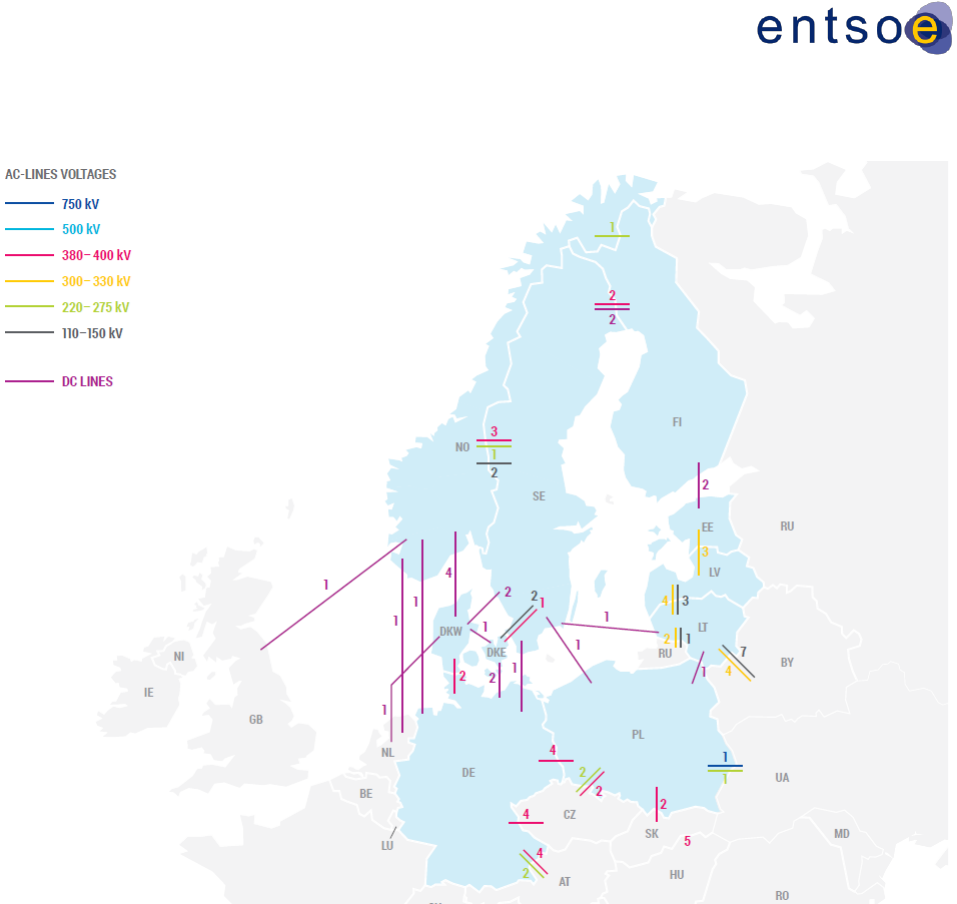
Regional Investment Plan 2022 – Baltic Sea
10
1. Note that Denmark is divided between two synchronous areas: Denmark-East, which is a part of
the Nordic system, and Denmark-West, which is part of the continental system.
Figure 3-1: Synchronous areas and existing interconnections in the Baltic Sea region
The Baltic States are currently in the same synchronous area as the Russian IPS/UPS power
system and have several AC connections to both Russia and Belarus. However, the Baltic system
has had no market exchange with Belarus since the end of 2021 or with Russia since May of 2022.
The interconnection capacities between the Baltic States are strongly dependent on the operations
of non-ENTSO-E countries; therefore, there is political motivation in the Baltic States to
desynchronise from the IPS/UPS system and synchronise with the European system. The
synchronisation project started on 28 June 2018 when the president of the European Commission,
Jean-Claude Juncker, together with the heads of state or government of Lithuania, Latvia, Estonia
and Poland, agreed on a political roadmap for the synchronisation of the Baltic States' electricity
networks with the continental European network via Poland, with a target date of 2025. In line with
that political roadmap, the BEMIP High-Level Group (senior-official level) on the synchronisation
project agreed on 14 September 2018 on the technical and economic feasibility of the
synchronisation option. It will consist of the existing double-circuit, alternating-current line between
Poland and Lithuania (LitPol Link), complemented by the construction of an offshore high-voltage
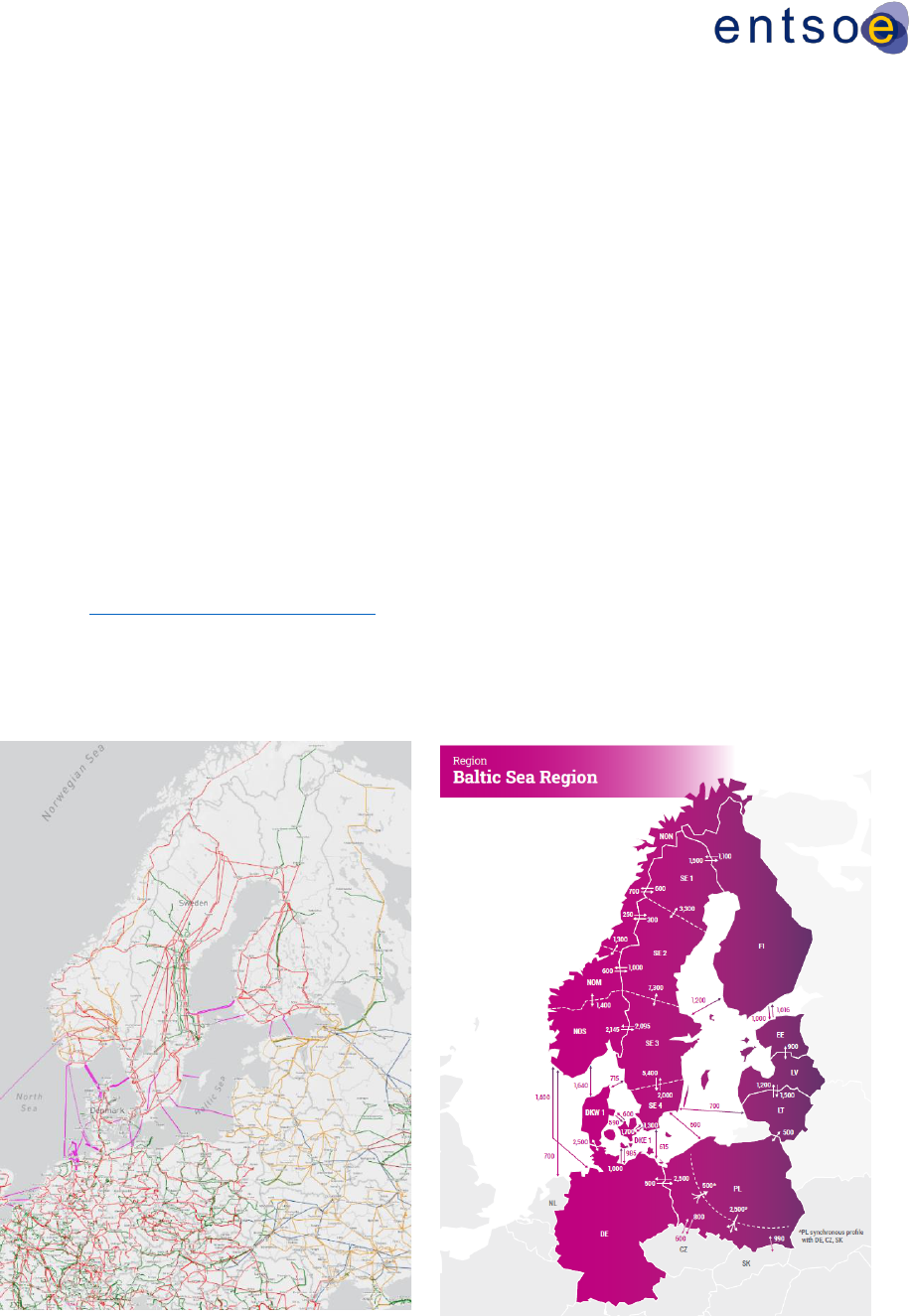
Regional Investment Plan 2022 – Baltic Sea
11
direct current link, together with other optimisation measures including synchronous condensers.
The status of the Baltic Synchronization project is described in Chapter 4.1.
Transmission capacity will play a key role in addressing future power system challenges.
Adequate transmission capacity allows for the cost-effective utilisation of power, ensures access to
adequate generation capacity, enables the smooth exchange of system services and is key to a well-
integrated market. A cost-effective transition towards a green power system depends largely on the
strength of the transmission networks. Therefore, transmission network improvements must be
completed in a timely fashion.
Many new HVDC interconnectors since 2010.
Seven new interconnectors have been commissioned since 2010, which has increased total
capacity by approximately 4450MW. These new interconnectors are Skagerrak 4 (Norway-
Denmark), Fenno-Skan 2 (Sweden-Finland), Estlink 2 (Estonia-Finland), Nordbalt (Sweden-
Lithuania), the LitPol link (Lithuania-Poland), Cobra (Denmark-The Netherlands) and the Kriegers
Flak CGS (Denmark-Germany) project. Two new HVDC connections are to be commissioned in the
region during the next five years: the Harmony Link (Poland-Lithuania) and the Hansa PowerBridge
I (Sweden-Germany). Preparatory work for the construction of the Harmony link – HVDC link
between Poland and Lithuania started in 2019 as a part of the Baltic synchronisation project.
The Interconnected HVAC network in the Baltic Sea region is illustrated in Figure 3-2 and is
also found at https://www.entsoe.eu/map/. The Nordic and continental systems utilise 400kV AC
as the main transmission voltage level and 220/130/110kV AC as sub-transmission voltage levels.
In the Baltic States’ power system, the main transmission voltage level is 330kV. The map in Figure
3-3 shows the diverse level of net transfer capacities (NTC) in the Baltic Sea region. The NTC is the
maximum total exchange capacity in the market between two adjacent price areas.
Figure 3-2: Interconnected network in the Baltic
Sea region
Figure 3-3: NTCs in the Baltic Sea region
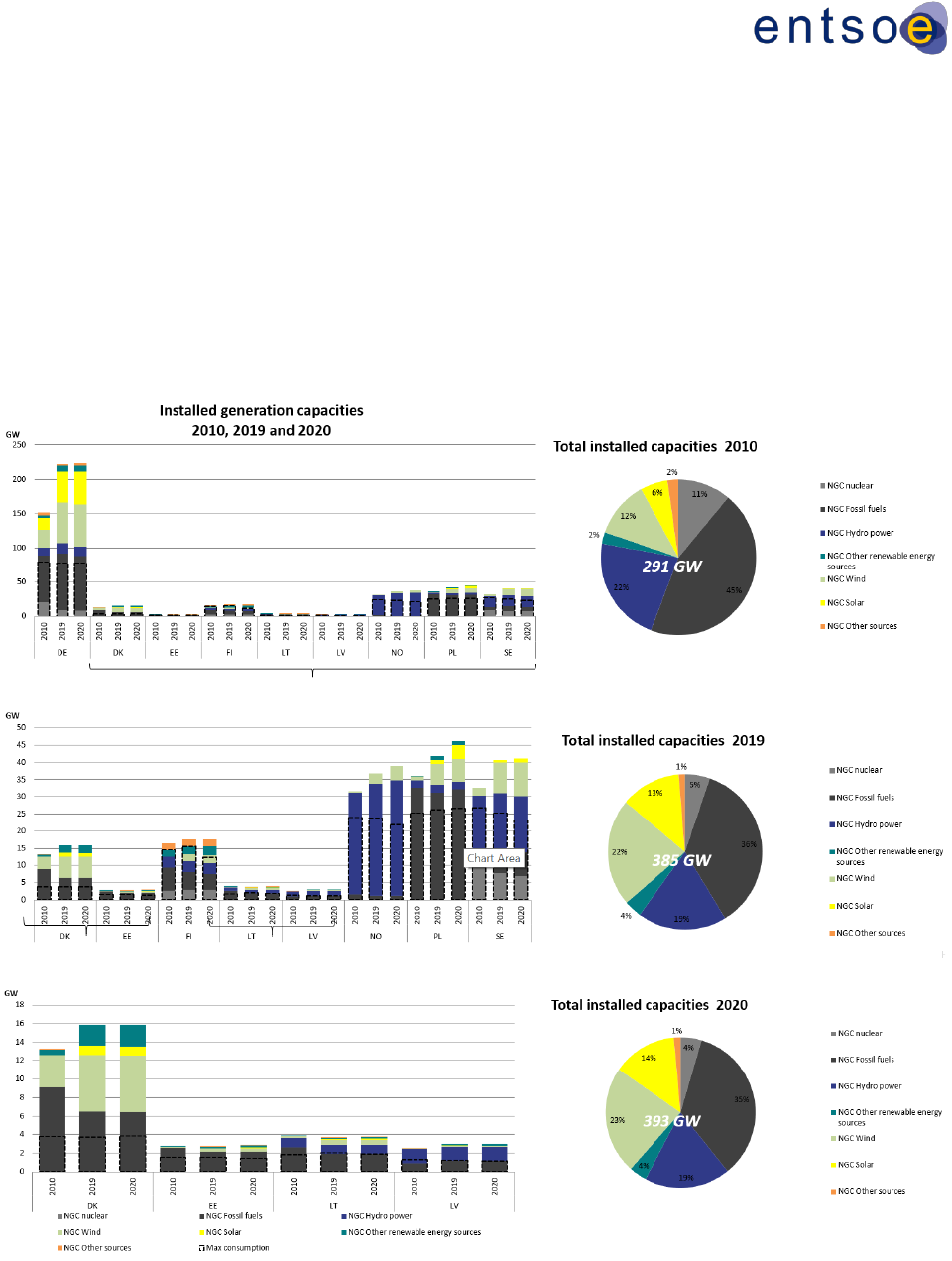
Regional Investment Plan 2022 – Baltic Sea
12
3.1.2 Power generation, consumption and exchange in the Baltic Sea region
The total annual power consumption in the Baltic Sea region is approximately 1100 TWh, of
which half is consumed in Germany. The peak load is much higher in winter than in summer due to
colder weather and the high usage of electric heating in the Nordic and Baltic countries. During the
last ten years, the peak load in the region has only shown moderate growth, while renewable
generation capacity has greatly increased, as shown in Figure 3-4. Thermal, fossil fuel-fired
generating capacity has decreased in the Nordic countries, while it has slightly increased in
continental Europe. The German nuclear phaseout is also clearly visible in the figure.
Figure 3-4: Installed generation capacities by fuel type and maximum consumption in the Baltic Sea region in
2010, 2019 and 2020

Regional Investment Plan 2022 – Baltic Sea
13
The continental and Nordic markets currently have sufficient thermal production capacity to
cover demand during periods of low production from variable renewable sources or dry years with
low hydro production. Currently, most of the countries have enough reliably available capacity to
cover peak load without having to import from neighbouring countries. However, the trend in many
countries is also towards dependency on imports in peak load situations due to the increase in
renewable generation capacity.
Figure 3-5: Annual generation by fuel type and annual consumption in the Baltic Sea region in 2010, 2019
and 2020
The Nordic power system is dominated by hydropower, followed by nuclear, wind and
combined heat and power (CHP). Most of the hydropower plants are located in Norway and northern
Sweden, and the nuclear power plants are located in southern Sweden and Finland. During a year
with normal inflow, hydropower represents approximately 50 % of annual electricity generation in the
Nordic countries, but variations between wet and dry years are significant. For Norway, the variations

Regional Investment Plan 2022 – Baltic Sea
14
can be almost 60 – 70 TWh between a dry and wet year. Consumption in the Nordic countries is
characterised by a high amount of electrical heating and energy-intensive industries. The power
balance in the region is positive in a normal year but varies significantly between wet/warm and
dry/cold years. Sweden and Norway have energy surpluses, whereas Finland has an energy deficit
and is dependent on imports. The development of generation and demand in the Baltic Sea region
is shown in Figure 3-5.
Power production in the continental part of the Baltic Sea region and the Baltic States area
is dominated by thermal power, except in the Danish power system, which is dominated by wind and
other RES, which account for more than 60 % of consumption in Denmark. Consumption in the area
is less temperature dependent than in the Nordic countries. Denmark, Poland, Estonia and Latvia
have a neutral annual power balance during an average year, whereas Germany has a yearly
surplus. Lithuania, on the other hand, is currently operating with a large energy deficit. The massive
increase in RES generation in Germany has replaced nuclear production but has only slightly
decreased fossil fuel-based generation while significantly increasing exports.
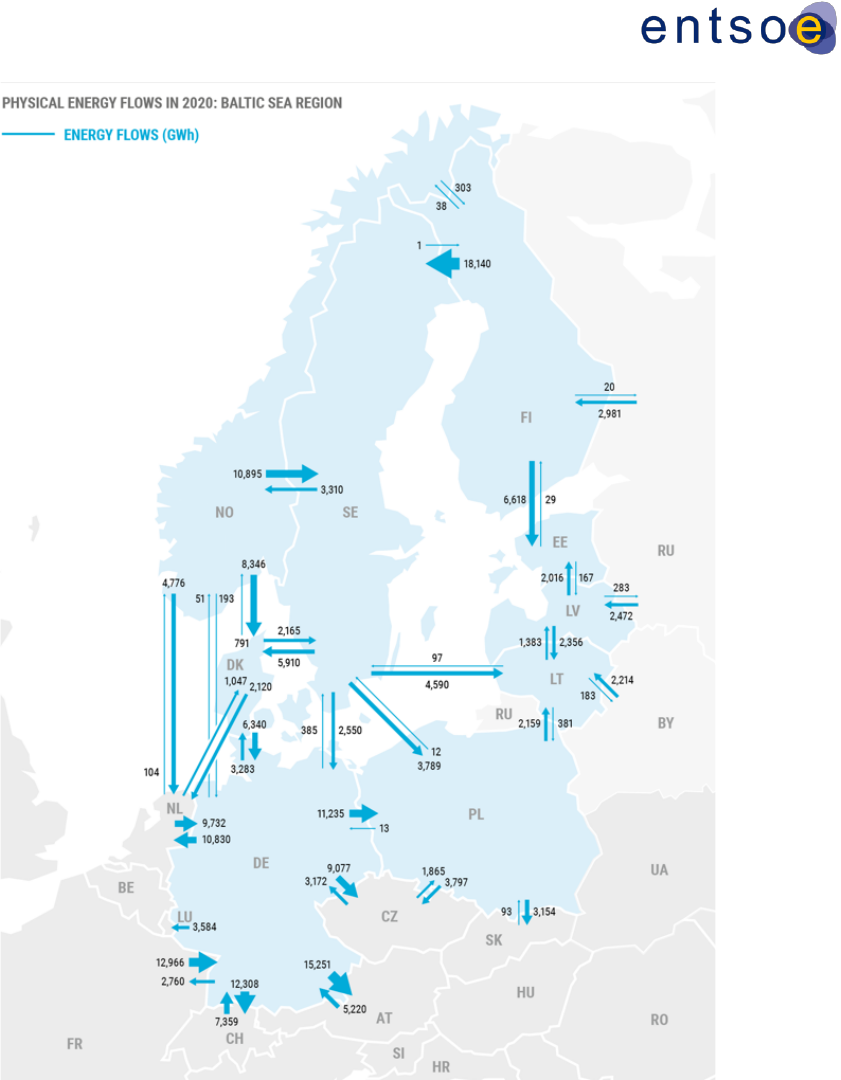
Regional Investment Plan 2022 – Baltic Sea
15
Figure 3-6: Cross-border physical energy flows (GWh) in the Baltic Sea region in 2020
Cross-border flows in 2020 are shown in Figure 3-6, and the development of cross-border
exchanges from 2010 to 2020 is presented in Figure 3-7. The largest exchanges were from Norway,
Sweden and Germany to neighbouring countries, while the largest increases in power flow between
2010 and 2020 were from Sweden to Finland, Norway to Sweden, the Netherlands to Germany and
Germany to the Czech Republic. In the Nordic countries, the flow pattern varies greatly from year to
year as a result of variations in hydrological inflow (for example, 2010 was a dry year). In wet years,
exports from Sweden and Norway are typically much larger than during dry years. In addition, Finnish
imports from Russia have decreased as a result of a new market design in Russia, which has

Regional Investment Plan 2022 – Baltic Sea
16
significantly increased the price of exports during peak hours. In practice, this has limited Finnish
imports to nights and weekends. Furthermore, the electricity trading between Finland and Russia
was suspended in spring 2022 and remains suspended at the time of the writing of this report.
Figure 3-7: Cross-border physical energy flows (GWh) in the Baltic Sea region in 2010, 2019 and
2020

Regional Investment Plan 2022 – Baltic Sea
17
3.2 Description of the scenarios
The scenarios in which the studies in this report have been performed are presented in this
chapter. First, the expected changes in the generation portfolio of the region are explained, followed
by a description of the pan-European TYNDP scenarios.
Building on the previous scenario reports, the cooperative work of gas and electricity planning
experts across Europe and the public consultation, the TYNDP 2022 Scenario Report includes two
COP21-compliant scenarios designed to capture the impact of the fast-moving and fast-paced
energy transition on the electricity and gas infrastructure. The report contains a series of important
highlights for the future of Europe's energy system:
• Net zero can be achieved by 2050 while ensuring the security of the energy supply
• Energy efficiency is key to achieving the EU’s long-term climate and energy objectives
• The ambitious development of renewable energy across Europe
• Integrated energy systems: hydrogen is a game changer for gas and electricity systems
• Innovation is key to achieving a sustainable energy future
3.2.1 Storylines
Storylines aim to ensure that sufficient differences are made between the scenarios by correctly
identifying high-level drivers and quantifying their outcomes. The energy landscape is constantly
evolving and scenarios need to keep pace with the main drivers and trends affecting the energy
system and, in particular, the gas and electricity infrastructures. Based on engagement with the
stakeholders, ENTSOG and ENTSO-E identified four high-level drivers:
• The green transition determines the level of GHG reduction targets and is one of the most
important political drivers of the energy scenarios.
• Beyond climate targets, the European energy system will be increasingly shaped by societal
decisions and initiatives.
• Energy intensity is a result of innovation and consumer behaviour and may have a major
effect on transitions in the energy system.
• Technological progress is a driver of energy system evolution.
3.2.2 Scenarios cover different time horizons
For both 2024 and 2025, ‘best estimate’ scenarios were developed. For the quantification of this
time horizon, ENTSOG and ENTSO-E used data collected from the TSOs. These figures reflect the
national and European regulations in place at the end of 2020. The long-term goals, starting from
2030, are covered by three different scenarios, reflecting increasing uncertainties towards 2050.
The National Trends scenario is in line with national energy and climate policies (NECPs , national
long-term strategies, hydrogen strategies, etc.) derived from the European targets. The electricity
and gas datasets for this scenario are based on figures collected from the TSOs and translate the
latest policy- and market-driven developments discussed at the national level. The National Trends
scenario is quantified using electricity and gas up to 2040.

Regional Investment Plan 2022 – Baltic Sea
18
In addition to the National Trends scenario, ENTSOG and ENTSO-E have developed two
COP21- compliant scenarios. Both scenarios aim at achieving the 1.5 °C target of the Paris
Agreement following the carbon-budget approach. They are developed on a country level until 2040
and on a EU27 level until 2050.
Distributed Energy pictures a pathway achieving EU-27 carbon neutrality by 2050 and at least a
55% emission reduction by 2030. The scenario is driven by a societal willingness to achieve energy
autonomy based on widely available, indigenous, renewable energy sources. It translates into both
a way-of-life evolution and a strong, decentralised drive towards decarbonisation through local
initiatives by citizens, communities and businesses, supported by authorities. This leads to a
maximization of renewable energy production in Europe and a strong decrease in energy imports.
Global Ambition (GA) pictures a pathway to achieving carbon neutrality by 2050 and at least a 55%
emission reduction by 2030, driven by a global move towards the Paris Agreement targets. It
translates into the development of a wide range of renewable and low-carbon technologies (many
being centralised) and the use of global energy trading as a tool to accelerate decarbonization.
Economies of scale lead to significant cost reductions in emerging technologies such as offshore
wind, but imports of decarbonised energy from competitive sources are also considered viable
options.
Please refer to the Scenario Report and visualisation platform for the results of the three scenarios.
This material will provide an insight into the development and outcomes of the scenarios mentioned
in this report.
3.2.3 Key findings of the scenarios for the Baltic Sea region
The main drivers for change in the regional generation portfolio are explained in this chapter as a
basis for the regional scenarios. The challenges expected due to these changes are then elaborated
on in Chapter 3.1.2. The main drivers of change in the Baltic Sea region are related to climate policy,
which is stimulating the development of more RES and a common European framework for the
operation and planning of the electricity market. The main structural changes anticipated in the Baltic
Sea region power system in the future relate to the following:
• Strong increase in RES generation
− An increased share of renewable sources in the power system is shown in all
scenarios
− Additional wind power generation will occur mainly in the northern and middle part of
the region, which is located farther away from the main load centres in the middle and
southern parts of the region
− PV capacity will be mainly increased in the middle and southern part of the region
• Reduction of thermal power capacity
− Decommissioning of old lignite, hard coal and oil-fired power plants
− Full decommissioning of all nuclear power plants in Germany by the end of 2023
− Four nuclear units in Sweden, with a total capacity of 2900MW, were
decommissioned in the period 2015-20. The remaining six units are expected to reach
the end of their technical lifetimes around 2040
• New large generating units
− New nuclear capacity is being built in Finland, with one unit of 1600MW anticipated
to be commissioned in 2022
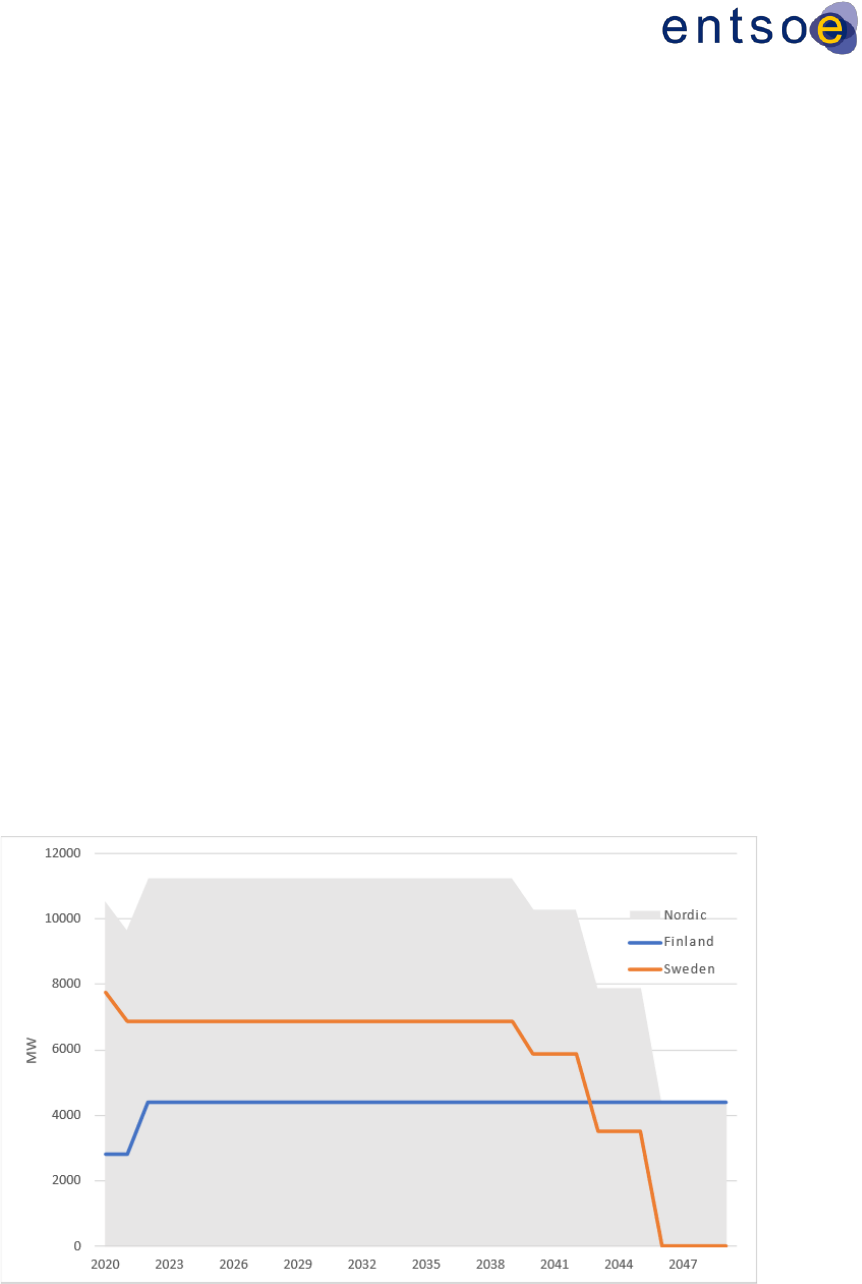
Regional Investment Plan 2022 – Baltic Sea
19
− Before 2040, new nuclear-generating units will be built in Poland, with a total installed
capacity of 4400 MW
− Large wind power generation units are planned throughout the Baltic States region
• Significantly increased battery storage capacities are to be achieved through technological
advances in all scenarios to serve the flexible RES power generation
• An increased capacity for hydrogen production will receive attention in all scenarios
• Power to gas generation capacities will increase sharply, but mainly in the Distributed Energy
scenario
Variable renewables will account for an increased share of energy generation
Historically, the development of renewable generation has been based on subsidies. Lower
development costs, gradual improvements in solar cell efficiency and increasingly larger wind
turbines with a higher number of full-load hours will reduce the overall costs per MWh for both solar
and wind power. Today, solar power and wind power, if located favourably, can be profitable without
the need for subsidies. This is leading to changes in their geographical distribution as it is more
profitable to develop solar and wind power in the locations with the best conditions and lowest costs.
For example, there is much interest in greater development in the Nordic and Baltic regions, which
have some of the best wind resources in Europe. Development can proceed very rapidly, with some
market participants already planning to build new wind turbines without subsidies.
Nuclear phaseout continues in Sweden, while Finland and Poland build new capacity
Nuclear power in Sweden and Finland plays a key role in the Nordic power system. It represents
25% of overall annual power generation in the Nordic countries. Nuclear power delivers a stable and
predictable baseload near consumption centres, and its contribution during dry years is important.
Moreover, the power plants contribute stability to the Nordic grid, and many are strategically located
in areas where they can fully support the capacity of the power grid.
Figure 3-8: Expected developments in Nordic nuclear power capacity from 2020 to 2050 used in the scenario
building, based on an expected lifetime of 50 to 60 years

Regional Investment Plan 2022 – Baltic Sea
20
The further development of nuclear power in Sweden and Finland is a key uncertainty in the
Nordic power system and the market. All of the current active reactors started operating between
1972 and 1985, with a planned lifetime of 50 to 60 years. Swedish nuclear power plants have been
under financial strain in recent years due to low power prices, increased taxes and high capital costs
from earlier investments in maintenance and capacity extension. As a result, four reactors with a
total capacity of 2900MW were decommissioned during the years 2015–2020. This means that
energy generation will decline from 65TWh a year currently to approximately 50TWh. Furthermore,
a Swedish energy policy implemented in the summer of 2016 included the decision to remove the
special tax on output, which had a severe impact on nuclear power (Figure 3.8).
In Finland, there is some political support for further investment in nuclear power. However,
the Hanhikivi 1 NPP project (1200 MW) was recently cancelled due to the Russia-Ukraine war.
Olkiluoto 3 (1600 MW), on the other hand, will be in operation before any older nuclear plants are
decommissioned.
In addition to the massive development of renewable sources, an important element in the
transformation of the energy generation sector in Poland is the development of nuclear power plants.
On 2 October 2020, the Council of Ministers approved the Polish Nuclear Power Program (PPEJ),
which sanctioned the construction of nuclear power plants with a total capacity of approx. 6–9 GW.
According to the provisions of the PPEJ, the first nuclear power unit is to be commissioned in 2033.
The next units are to be put into operation every two years until 2043. In 2040, nuclear power plants
with a total capacity of 4400 MW are expected to be built in Poland.
Reduced utilisation hours for thermal capacity and flexibility needs
The continental and Nordic markets currently have sufficient thermal production capacity to
cover demand during periods of low production from variable renewable sources or dry years with
low hydro production. The increasing share of variable renewables is reducing both the usage and
profitability of thermal plants, and a significant share of thermal capacity will probably be shut down.
This will, in turn, reduce the capacity margin (the difference between the available generation
capacity and consumption) in the day-ahead market and will result in tighter margins. This type of
situation is particularly observed in Poland, where the capacity margin will decrease drastically with
the increase in installed RES in the country's system.
The high percentage of hydro production with reservoirs in the Nordic region provides large
volumes of relatively cheap flexibility, both in the day-ahead market and during operational hours. In
addition to hydropower, flexible coal and gas power plants also provide both long- and short-term
flexibility, though at a higher cost than hydropower. Until now, the flexibility from hydro plants with
reservoirs has been enough to cover most of the flexibility needed in Norway and Sweden, as well
as a significant proportion of the flexibility demand in Denmark, Finland and the Baltic countries. This
has resulted in relatively low price volatility in the day-ahead market and made possible the balancing
of costs. A higher market share of variable renewables will be the main driver of increased demand
for flexibility because the flexibility provided by existing hydro plants is limited and thermal capacity
is declining.
3.2.3 Technical challenges of the power system
Two significant changes in the Baltic Sea region challenge the power system’s further
development needs. The biggest challenge in the region as a whole is how to cope with a significant
increase in RES generation. The majority of the future RES increase will come from solar and
onshore and offshore wind. The current mainland transmission network might not be suitable and
sufficient for offshore wind, and therefore offshore grid developments are inevitable. The increasing

Regional Investment Plan 2022 – Baltic Sea
21
share of RES in the generation portfolio will be connected with the grid as power park modules. This
means that they will be converter coupled and therefore will not provide natural short circuit and
inertia support. This technological change might bring new challenges related to frequency stability
and the minimum short circuit power necessary to operate equipment in normal conditions. The
power park modules and the required capabilities are specifically described in the EU Requirements
for Generators (RfG) code. A power park module (PPM) means a unit or ensemble of units
generating electricity that is either non-synchronously connected to the network or connected
through power electronics and also has a single connection point to a transmission and distribution
system, whether a closed distribution system or HVDC system (Article 2(17) of the Network Code
on Requirements for Grid Connection of Generators).
1
Besides the change in the technical
characteristics of the power system, the change in RES will result also in higher price volatility and
sudden changes in power flow in different parts of the power system depending on the location of
the RES source in given weather conditions. It is also very difficult to plan and predict exact flow
patterns as weather conditions are indefinite. Therefore, the system must develop sufficient
transmission capabilities to cope with high and changing flows and the ability to compensate for the
risks deriving from changes in system characteristics such as inertia and short circuit power.
The second big technical challenge which primarily affects the Baltic States is the Baltics’
power system synchronisation with the continental Europe synchronous area, which will require
several technical and system changes. A more specific technical solution and plan are described in
the separate synchronisation project in Chapter 4.1. Considered separately, the Baltic power system
is rather small, with a peak load of roughly 5GW. Historically, it has operated as part of the Russian
power system IPS/UPS, in which the responsibilities are divided differently than in the EU system.
So, a major challenge will be the change in the way that the system will be operated. In the Russian
system, the frequency is controlled centrally, while in the EU the responsibility is shared
proportionally among the members connected to the same synchronous area.
Due to the technical solution chosen for the future synchronous interconnection between
Lithuania and Poland, there is a small but still significant probability that the Baltics could be
disconnected from the continental synchronous system and placed in island operation mode during
an exceptional contingency which tripped the only double-circuit, high-voltage, 400kV overhead line
that connects the Baltics with the rest of Europe. This situation could, technically, be handled, but it
is a big technical challenge that will require additional technological investment in enabling sufficient
system inertia and limiting the Rate of Change of Frequency (RoCoF) to an acceptable level and
allowing superfast activation of countermeasures to restore the system balance and frequency
stability. Technical challenges presented by increases in RES generation that have been identified
by TSO experts include:
• Frequency stability issues due to reduced inertia, increased deviation range and ramp rate
of generation and larger contingencies;
• Voltage stability issues due to longer transmission paths and reduced voltage control near
load centres; and
• Angular stability issues, due to reduced minimum short circuit current levels.
New interconnections and synchronous condensers with increased inertia are part of the
solution when it comes to providing flexibility, while factors such as energy and electricity storage
and demand response can also help balance energy levels. From a dynamic stability perspective,
the flexibility needed to keep the power system running when the penetration of synchronous
machines is reduced can be provided by RES generation units, the use of flexible AC transmission
1
Source (footnote): https://www.emissions-euets.com/internal-electricity-market-glossary/830-power-park-module-ppm

Regional Investment Plan 2022 – Baltic Sea
22
(FACTS) devices, controlling HVDC links and using solutions such as dynamic line rating and special
system protection schemes. Decreases in inertia, short circuit power and voltage regulation near
load centres are a few of the main issues that must be solved as the generation portfolio becomes
increasingly CO2-free.
Decreased inertia
One of the major challenges identified is the decrease in inertia when synchronous
generation decreases and converter-connected generation increases within the system. Inertia is
the kinetic energy stored in the rotating masses of machines, and the inertia of a power system
resists the change in frequency after a step change in generation or load.
Too little inertia can lead to frequency instability, in which a sudden change in generation and
load balance results in unacceptable frequency deviations and, potentially, cascading tripping in the
system elements and possible blackouts in worst-case scenarios. The low-inertia situation is only
expected in the Nordic synchronous system in the medium term, and in the event of island operation,
also in the Baltic system. The amount of inertia in future Nordic synchronous power systems has
been analysed by the Nordic TSOs.
One of the possibilities for compensating for the decrease in system inertia is to provide a
temporary, fast-response, active power injection from the wind production units, decoupled from the
grid with converter technology. The temporary boost of active power support following a sudden
decrease in frequency could be achieved by utilising the kinetic energy stored in the wind turbine
rotors and generators. Reaction time and control would not be instantaneous but with today’s
advanced power electronics should be fast enough to support the system and prevent sudden
frequency drops. This method of control could cause a slight decrease in power output after the
utilisation of the stored kinetic energy of the rotating turbines as the wind turbine blades would not
be rotating at the optimal speed for achieving maximum production at certain wind speeds. The
maximum output would typically be restored in a very short time (several tens of seconds) after the
use of the synthetic inertia. In case of further RES increases, synthetic system inertia could be
considered as a basic function for rotating RES units decoupled through power electronics.
Decreased voltage regulation near load centres
Much planned wind power production is located far from the load centres where the
conventional units are and have traditionally been located. Therefore, a large extension of reactive
power compensation devices will be necessary because power will have to be transmitted over long
distances and the dynamic voltage support will be less than with the conventional units. For example,
in both Germany and the Nordic countries, wind power from northern areas will need to be
transmitted to load centres in southern areas.
Decreased minimum short circuit power
Directly connected synchronous generators provide short circuit current and voltage support
regulation during faults that are necessary for the normal operation of certain types of converter
technologies to avoid commutation failures. Insufficient short circuit power support might lead to the
tripping of the line-commutated converters (LCC), which are technology-based. Furthermore, when
the penetration level of converter-connected power generators is very high, the form of the fault
current is determined by the controls of the converters and not by the short circuit output of rotating
machines, which can cause issues with the protection devices that are designed to work in a system
based on synchronous machines. When designing future power systems, these technical issues
should be studied in more detail and sufficient countermeasures developed.
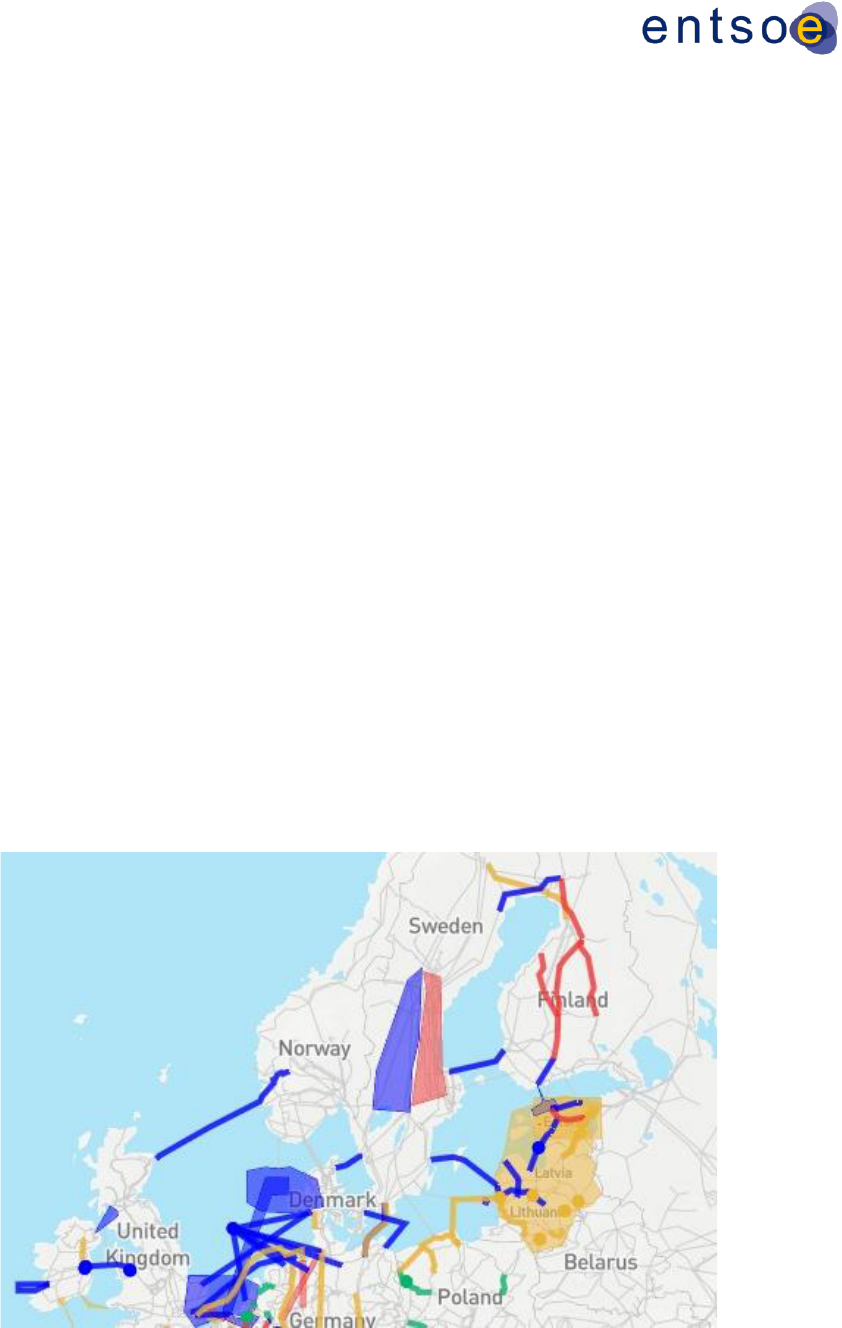
Regional Investment Plan 2022 – Baltic Sea
23
3.3 Regional System Needs
This chapter illustrates and explains the results of the regional studies. It is divided into two
sections. Subchapter 3.3.1 describes the future capacity needs that were identified during the IoSN
process. Subchapter 3.4 provides the detailed outcomes of the IoSN that relate to market results.
3.3.1 Future capacity needs
The Baltic Sea region’s energy system is in flux. Over recent years, onshore wind capacity
has been added at an increasing rate. More recently, in parts of the region, offshore wind generation
has been developed in significant quantities. The expansion of renewable generation, alongside
existing hydro generation, is providing the region with increased amounts of ‘clean’ energy. Thermal
generation may be largely phased out. Finally, nuclear generation is undergoing major restructuring.
It will be discontinued in Germany by the end of 2022. In Sweden, some nuclear units have been
decommissioned for economic reasons, but the remaining capacity is expected to be available until
around 2040 when the units’ technical lifetimes are reached. All of the shifts in generation described
above are expected to become more pronounced in the future. In addition, electricity consumption
is changing due to increasing electrification in industry and transportation and the entry of consumers
into the production system as prosumers.
Different scenarios have been developed to analyse future capacity needs. Potential
changes in both generation and consumption are described in the first phase of the TYNDP 2022
process through the construction of new scenarios for 2030 and 2040 and the assessment of system
needs for the long-term 2040 horizon. Cross-border capacity increases are expected to have a
positive impact on the system in most of the development scenarios and various climate years. A
European overview of these increases is presented in the European IoSN developed by ENTSO-E
in parallel with the RegIPs. Figure 3-9 shows all of the projects of the TYNDP 2022 program. LasGo-
Link – the blue interconnector between Sweden (via Gotland) and Latvia – is not part of the national
development plan in Sweden. The Swedish TSO, Svenska kraftnät, earlier this year (February 2022)
rejected a grid connection inquiry from the promotor of the project.
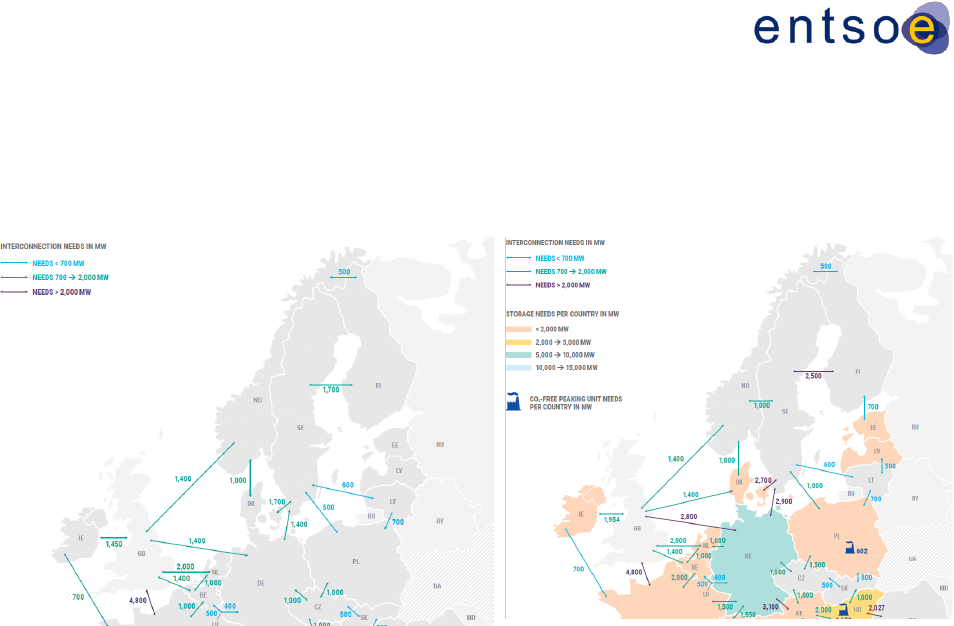
Regional Investment Plan 2022 – Baltic Sea
24
Figure 3-9: TYNDP 2022 project list
Projects categorised as ‘Under construction and ‘In permitting’ are part of Reference Grid 2025 and
are assumed to have been built by 2025. Figures 3-10 and 3-11 show the identified capacity
increases between 2030 and 2040 for the Baltic Sea region.
Figure 3-10: Identified capacity needs in 2030
Figure 3-11: Identified capacity needs in 2040
These figures are based on the 2030 and 2040 Pan-European System Needs analyses and
assume that the Reference Grid 2025 is already realised. They also show the effect on those
boundaries when another IoSN grid solution that is not part of the IoSN economic needs solution
would have similar benefits. This so-called upper bound capacity does not represent an alternative
grid solution but rather a different combination of increased boundary capacity, which would lead to
slightly more expensive benefits. Not all ‘upper bound’ capacity increases could be added to the
IoSN economic needs solution at the same time. However, adding one or two provides benefits
similar to those offered by the IoSN economic needs solution. The two figures show that, based on
the TYNDP 2022 projects, the project promoters and TSOs are partly covering the gap between
today's grid and future needs. However, many projects still need to be realised to meet future needs.
To cope with this long-term generation mix, the interconnected European power systems will need
to solve the following problems through cross-border capacity increases:
1. Insufficient integration of renewables into the power systems as high amounts of curtailed
energy occurred in a couple of power systems;
2. Insufficient market integration, including high system costs in certain market areas and high
price differences between the market areas;
3. High CO2 emissions; and
4. Insufficient cross-border capacities.
The ‘future capacity needs’ identified as part of the IoSN process are mainly due to the
change in the overall situation in the power systems in future scenarios such as load-flow pattern
changes. Therefore, the transmission system elements limiting cross-border capacity in the 2022
time horizon could change in 2040 due to the generation mix change – installed capacities and
locations of the power systems – as well as the partial strengthening of the grid infrastructure.

Regional Investment Plan 2022 – Baltic Sea
25
The effects of identified future capacity needs on the cross-border profiles in the Baltic States
region could potentially be covered, fully or partly, by the future transmission projects included in the
TYNDP 2022 process. If they are not, they will have to be met through future grid development. In
addition, the expectations for increased offshore wind might lead to new types of hybrid projects
combining offshore wind and interconnections between countries. This is to be further investigated.
As part of this work, cross-border capacity increases were identified that will have a positive impact
on the system. A European overview of these increases is presented in the European IoSN report
developed by ENTSO-E in parallel with the RegIPs. The system needs for the 2040 horizon are
evaluated with respect to (1) market integration/socio-economic welfare, (2) integration of
renewables, (3) reduction of greenhouse gas emissions and (4) security of supply. For the Baltic
Sea region, the 2040 needs are primarily anticipated to be met by:
• Synchronisation of the Baltic system with the continental system and further internal
integration within the Baltic region to improve the security of supply;
• Offshore wind parks – if these are realised, the energy will have to be transported to the
onshore system;
• Further Sweden-Finland integration to increase market integration and address the negative
Finnish energy balance;
• Further integration between Sweden and Germany due to price differences and for better
optimisation of RES generation (hydro/wind);
• Further integration between Sweden and Denmark due to price differences and for better
optimisation of RES generation (hydro/wind);
• Further integration between Denmark and Norway due to price differences and for better
optimisation of RES generation (hydro/wind);
• Further integration between Sweden and Norway due to price differences;
• Further integration between Sweden and Lithuania due to price differences and for better
optimisation of RES generation;
• Further integration between Sweden and Poland due to price differences;
• Further integration between Poland and Lithuania due to price differences and for better
optimisation of RES generation;
• Further integration between Lithuania and Latvia due to higher market integration for and
optimisation of RES generation;
• Further integration between Estonia and Finland due to price differences and for better
optimisation of RES generation.
The IoSN results are very much dependent on the scenario assumptions. For some of the
results, the trends are not fully aligned with the scenario assumptions made two years ago. The
offshore wind goals and development within each country have become more progressive. Also, the
fact that the IoSN analysis is based on only three climate years makes some of the results less
reliable than through the scenario process. In addition, internal costs are not fully taken into account
for several of the investigated borders – for example, Norway–Finland and Sweden–Finland. These
corridors require further investigation. The potential for increasing transmission capacity on the LT-
PL connection relates to the possibility of unblocking these capacities on the existing LitPol Link
connection. This is linked to increasing the resilience and robustness of the Baltic States’ grid after
synchronisation with continental Europe through this connection and the step-by-step release of
transmission capacity for trade. The needs for the region, detailed in the 2040 pan-European IoSN,
are partly covered by projects already waiting to be assessed in TYNDP 2022. Table 3-1 shows
cross-border capacities, including increases identified during the TYNDP 2022 process. The
columns in the table show the capacities relevant for the cost-benefit analysis (CBA), which will be
carried out on the 2030 and 2040 time horizons.

Regional Investment Plan 2022 – Baltic Sea
26
Border
NTC 2030
NTC 2040
=>
<=
=>
<=
DE-DEkf
400
400
400
400
DE-DKe
600
600
600
600
DE-DKw
3500
3500
3500
3500
DE-NSWPH
0
0
6000
6000
NSWPH-DKw
0
0
2000
2000
DEkf-DKkf
400
400
400
400
DE-Nos
1400
1400
1400
1400
DE-PLE
0
3000
0
3000
DE-PLI
2000
0
2000
0
DE-SE4
1315
1315
2015
2015
DKe-DKkf
400
600
400
600
DKe-DKw
600
590
600
590
DKe-SE4
1700
1300
1700
1300
DKw-NOs
1632
1632
1632
1632
DKw-SE3
715
715
715
715
EE-FI
1016
1016
1716
1716
EE-LV
1100
900
1100
900
FI-SE1
2000
2000
2800
2800
FI-SE3
1200
1200
1600
1600
LT-LV
800
950
800
950
LT-PL
700
700
700
700
LT-SE4
700
700
700
700
NL-Nos
700
700
700
700
NOm-NOn
1300
1300
1300
1300
NOm-NOs
1400
1400
1400
1400
NOm-SE2
600
1000
600
1000
NOn-SE1
700
600
700
600
NOn-SE2
250
300
250
300
NOs-SE3
2145
2095
2145
2095
PL-SE4
600
600
600
600
SE1-SE2
3300
3300
3300
3300
SE2-SE3
8100
8100
8100
8100
SE3-SE4
6200
2800
6200
2800
UK-NOs
2800
2800
2800
2800
DKw-NL
700
700
700
700
NSWPH-NL
0
0
4000
4000

Regional Investment Plan 2022 – Baltic Sea
27
DKw-GB
2800
2800
2800
2800
Table 3-1: Cross-border capacities relevant for the cost-benefit analysis, which will be carried out on the
2030 and 2040 time horizons
3.4 Market results of IoSN 2030 and 2040
The market simulations have been carried out using the Antares pan-European, open-source
market model, with a publicly available expansion module. The market results show that the
identified investments in the 2030 and 2040 grid will significantly decrease the general level of prices,
the amount of curtailed energy and the amount of CO2 emissions, compared to the No grid (after
2025) scenario. The three future grid development scenarios envisioned in the IoSN study have
been analysed in detail and are described and explained in the IoSN main report.
The outcomes of the economic optimization (from here on called the Economic grid) can be
compared with the case in which there is no further extension of the current grid after 2025 (from
here on called No grid) and the case in which only the currently planned grid investments are made
(from here on called the Portfolio grid).
Important observation: The results of the analyses of Norway, Sweden and Finland
present possible inconsistencies. ENTSO-E will further investigate them during the public
consultation period. These potential inconsistencies especially influence generation figures,
net balance and marginal cost.
Curtailed energy
The amount of curtailed energy decreases substantially in the IoSN in the Economic grid and
Portfolio grid scenarios, compared to the No grid scenario. Figures 3-12 and 3-13 show the curtailed
amounts of energy for the Baltic Sea region countries during the years 2030 and 2040. Among them,
the most significant energy curtailments have been in Germany, Denmark and Sweden, with
Germany facing the highest curtailments. The new grid capacity up to 2040 helps in situations in
which the RES share is large. In surplus situations in Germany and Denmark, surplus energy could
be exported and mostly stored in hydro reservoirs. In Sweden, curtailed energy decreases since
hydro reservoirs could often be full in a RES surplus situation. Therefore, increasing exports to the
rest of Europe will avoid curtailment issues, reducing the risk of having to spill during periods of high
RES. For the majority of the Baltic Sea region countries, the anticipated amount of curtailed energy
would be insignificant.
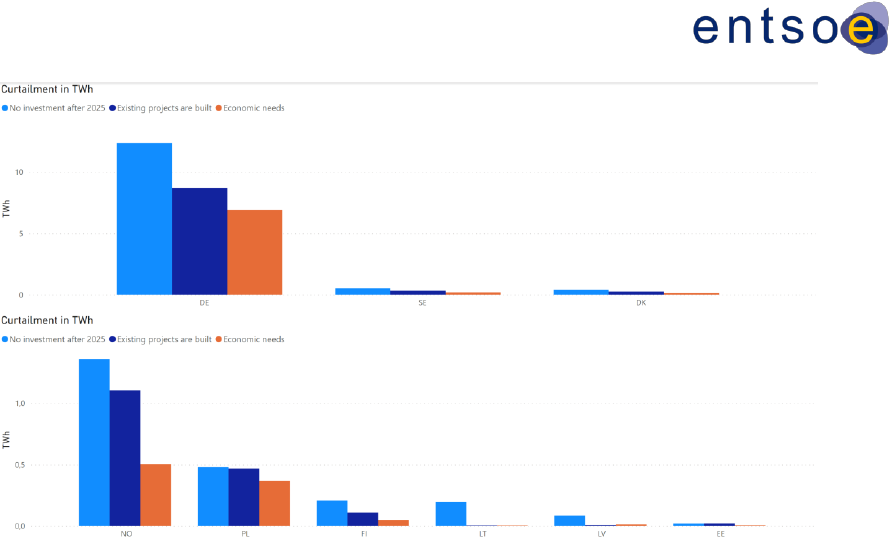
Regional Investment Plan 2022 – Baltic Sea
28
Figure 3-12: The amount of curtailed energy in the Baltic Sea region with and without identified capacity
increases in 2030
The results indicate that there would still be relatively large amounts of energy curtailment
with the Portfolio and Economic grid scenarios. However, the results likely exaggerate the absolute
level of curtailment since the modelling of wind power, in particular, does not fully consider the
expected increase in full load hours, meaning that the same amount of energy can be produced by
turbines with lower generation capacity. Even if the results are slightly exaggerated, the message is
clear: grid investments are needed to avoid large amounts of wasted renewable energy in the region,
and even more capacity than the 2040 grid may be needed, particularly with considerable variable
renewable generation. However, in a future power system with a very large amount of variable
generation, some curtailment needs to be accepted as avoiding curtailment completely will be too
expensive.
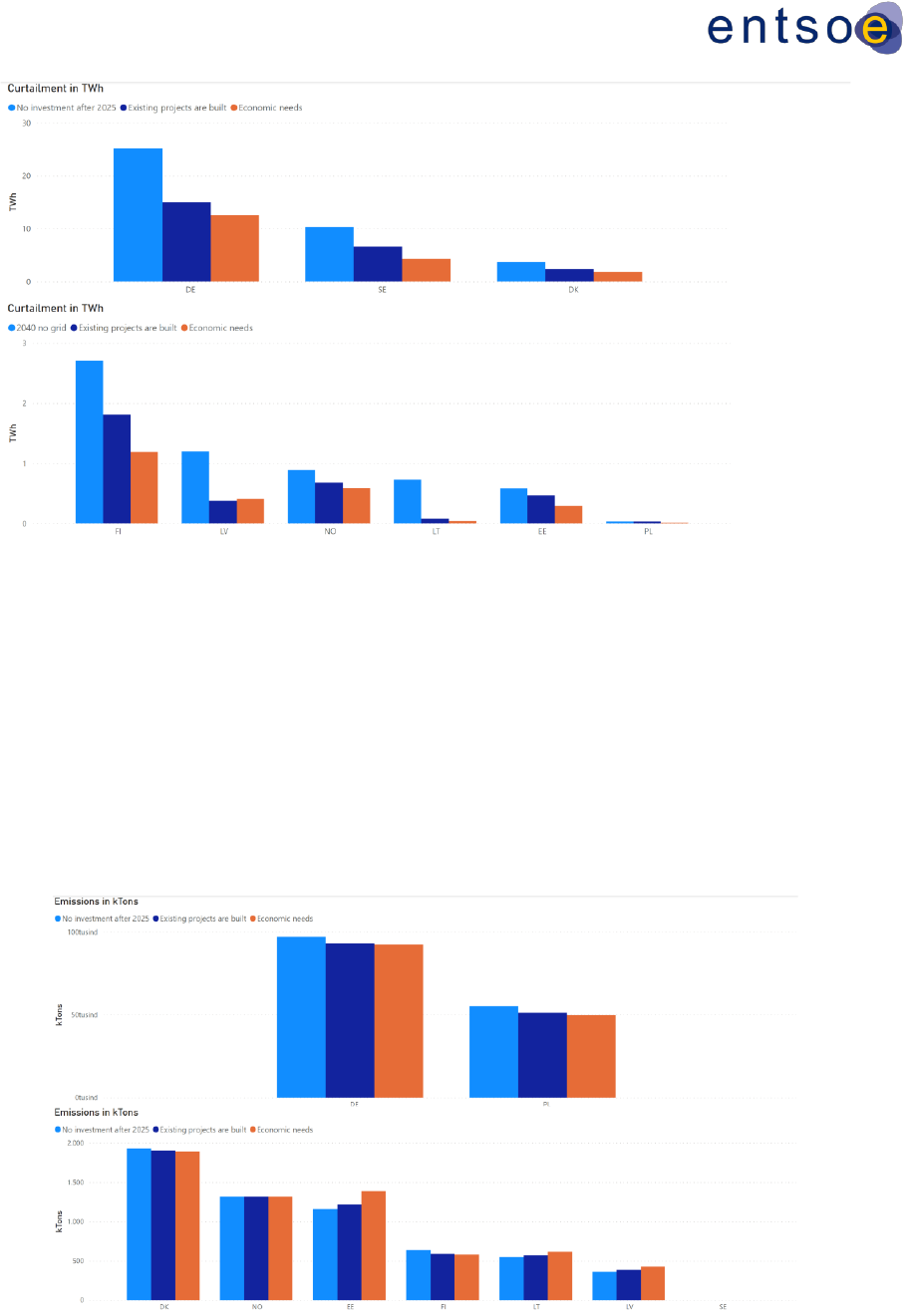
Regional Investment Plan 2022 – Baltic Sea
29
Figure 3-13: The amount of curtailed energy in the Baltic Sea region with and without identified capacity
increases in 2040
Decreased CO2 emissions
A higher interconnector capacity will also have an impact on CO2 emissions. This is due to
the better integration of zero-emission renewables and the move towards a carbon-neutral Europe,
as well as the increased use of gas in place of coal in thermal generation. There will be some
changes in Germany and Poland, but both countries will still have a significant amount of thermal
capacity in the 2040 scenario. The deployment of renewables has a greater effect on CO2 emissions
than the interconnectors as can be seen in Figures 3-14 and 3-15.
Figure 3-14: CO2 emissions in the Baltic Sea region, based on the IoSN (2030)

Regional Investment Plan 2022 – Baltic Sea
30
Figure 3-15: CO2 emissions in the Baltic Sea region (from the IoSN 2040)
Figure 3-16: CO2 emissions in different European regions (2040)

Regional Investment Plan 2022 – Baltic Sea
31
These figures show that the level of CO2 emissions is neither particularly high nor particularly
significant for the Baltic States and the Nordic countries and that both regions emit very low levels
of CO2 emissions. As CO2 emissions levels move towards zero, both regions are on course to meet
their EU 2050 CO2 emissions reduction targets. In contrast, both Germany and Poland have high
CO2 emissions levels, which will vary widely in the future depending on grid expansion. The reason
for these high CO2 emissions is the production of fossil fuels – lignite, coal and gas. Additional cross-
border capacity increases from Germany to the Nordic countries could reduce these CO2 emissions
levels. Comparing all scenarios for Germany and Poland, CO2 emissions are slightly reduced when
cross-border capacity is increased. However, more significant reductions can be seen if coal, gas
and lignite generation is reduced and replaced with CO2-free generation sources. For the other
countries, additional capacity increases will not significantly reduce the level of CO2 emissions.
Improved market integration and decreased average prices
As shown in Figures 3-17 to 3-20, the average price differences decrease when the
transmission network is expanded and new cross-border capacities are introduced. More
interconnector capacity between countries will reduce price differences and help develop a more
effective and integrated market. Therefore, it will be possible to import/export more power within a
shorter period when price differences are high, such as during dry years with higher prices in the
Nordic regions or periods when the variation in renewable production is high. The hydro-based power
market in the Nordics will become more integrated than the more thermal-based market in
continental Europe, and price variations between wetter and drier years will be lower.
Due to the potential errors observed in the hydro-modelling of the Nordics, the results for
some countries (especially Norway and Sweden) are not reliable.
Figure 3-17: Yearly average of marginal cost (€/MWh) identified in the Baltic Sea region (from the 2030
IoSN)
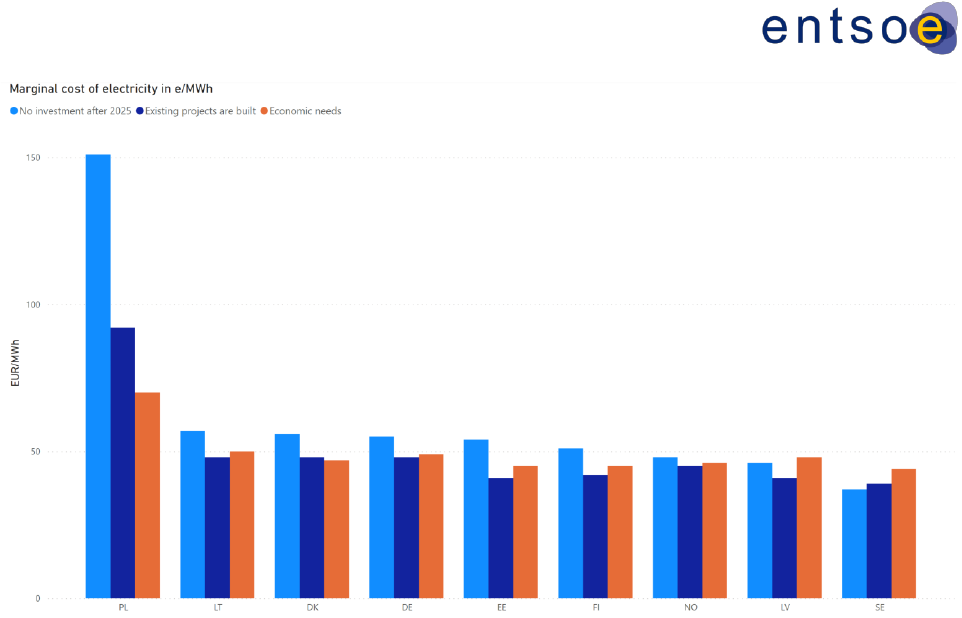
Regional Investment Plan 2022 – Baltic Sea
32
Figure 3-18: Yearly average of marginal cost (€/MWh) identified in the Baltic Sea region (from the 2040
IoSN)
On average, in the 2040 Portfolio grid scenario, marginal cost levels in the Baltic Sea region
countries are relatively close to each other. It should be noted that the results are very sensitive to
assumptions made regarding fuel and CO2 pricing. To integrate electricity markets and harmonise
marginal costs between the country groups within the Baltic Sea region, additional capacity
increases in these groups will be necessary.
A surplus in the western part of the region and a deficit in the eastern part
The net annual country balance in different investment scenarios shows that the main
electricity producers in the Baltic Sea region are Denmark, Norway and Sweden. Their export
amounts exceed their import amounts, and their energy is transmitted to Poland, Finland and
Germany (Figures 3-19 and 3-20). In the IoSN, the assumptions were slightly different from those
that have been made previously, and the change between climate years wasn’t given as important
a role as it should have been. Sweden will maintain a net annual surplus despite a reduction in
nuclear capacity by 2040. Depending on the scenario, the annual country balance will mostly hover
around zero for Lithuania, Estonia and Latvia. The annual balances for these countries will be very
close to zero because they have relatively small power systems compared with Germany, Norway,
Poland, Finland and Sweden. A significant amount of imported electricity is expected for Poland in
all scenarios. In Poland, domestic coal-fired generation will be partially replaced by imports. In
Finland, the balance will be close to 2015 levels as increases from new wind and nuclear generation
will be offset by growth in demand, as well as the decommissioning of existing nuclear and CHP
generation by 2040.

Regional Investment Plan 2022 – Baltic Sea
33
The potential errors observed in the hydro-modelling of the Nordic countries make the results
reported for them, especially for Norway and Sweden, unreliable.
Figure 3-19: Net annual country balance (export and import in wet climate year) in the IoSN Economic grid
scenario (2030)
Figure 3-20: Net annual country balance (export and import in wet climate year) in the IoSN Economic grid
scenario (2040)
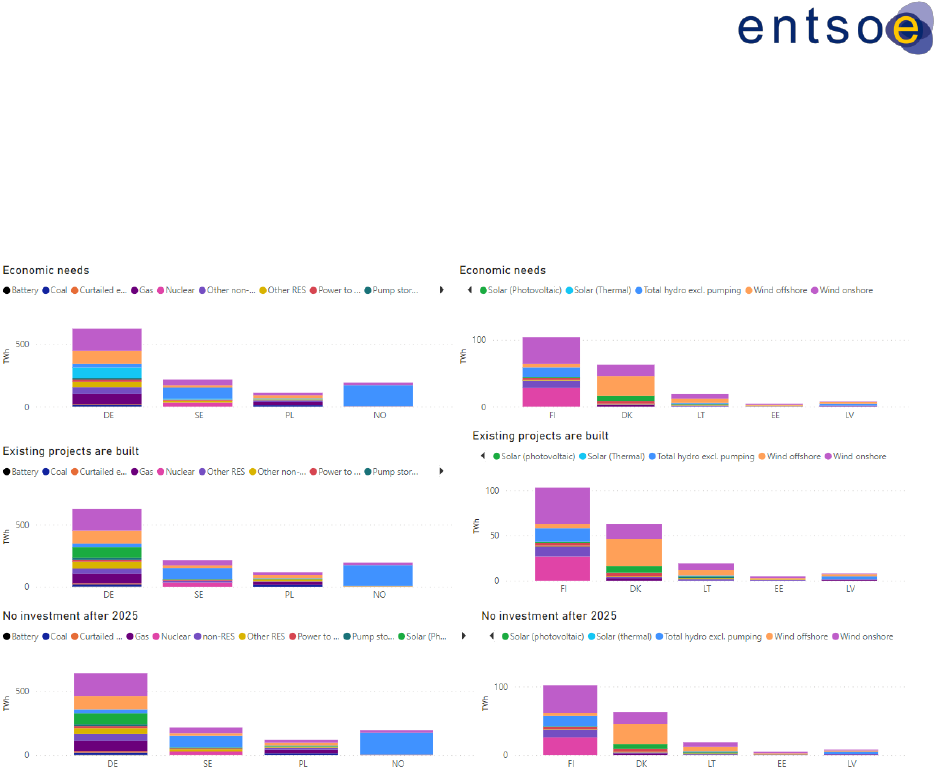
Regional Investment Plan 2022 – Baltic Sea
34
Electricity generation in all these countries will be based on offshore and onshore wind and
solar energy, hydropower and hydro storage, and biomass generation. The anticipated production
mixes from the IoSN 2030 and 2040 Economic grid scenarios are presented in Figures 3-21 and 3-
22. Hydro generation will have a major role in Norway and Sweden. Nuclear generation will continue
up to 2040 in Finland and Poland. The generation mix doesn't change significantly for most of the
Baltic Sea region countries among the scenarios.
Figure 3-21: Generation mix in TWh in the Baltic Sea Regional Group in the IoSN Economic grid scenario
(2030)

Regional Investment Plan 2022 – Baltic Sea
35
Figure 3-22: Generation mix in TWh in the Baltic Sea Regional Group in the IoSN Economic grid scenario
(2040)
Grid extension could reduce system costs
Figures 3-23 and 3-25 display the change and comparative system costs in the different
scenarios for the countries of the Baltic Sea area for the years 2030 and 2040. The system costs will
decrease for several countries with increasing grid development (Germany and Poland and, to a
lesser extent, Denmark and Finland). However, grid development could increase the system costs
in a few countries (i.e. Sweden and mainly Baltic countries).

Regional Investment Plan 2022 – Baltic Sea
36
Figure 3-23: System costs in MEuro in the Baltic Sea Regional Group (2030)
Figure 3-25: System costs in MEuro in the Baltic Sea Regional Group (2040)

Regional Investment Plan 2022 – Baltic Sea
37
4. REGIONAL STUDIES
4.1 Baltic synchronisation
The Baltic States currently operate in synchronous mode with the Russian and Belarussian
electricity systems (IPS/UPS – Integrated Power System / Unified Power System), forming the so-
called BRELL ring (Belarus-Russia-Estonia-Latvia-Lithuania). The energy policy of the Baltic States
is integrated with the energy strategy of the EU and must comply with major objectives such as
sustainable development, electricity market competitiveness and security of supply. In addition to
these objectives, the Baltic States have to continue developing competitive and fully integrated
electricity markets, along with a sufficiently developed energy infrastructure to connect distributed
RES (wind, biomass and biogas, solar, etc.) and meet EU energy neutrality targets.
In addition to the significant issues mentioned above, since 24 February 2022, the EU and Baltic
States have directed intense attention to the relationship between Russia and Ukraine, the
geopolitical situation, and Russia’s military aggression. This situation provided compelling reasons
to shift from the Russian and Belarus integrated power systems to the continental European power
system even before the previously set deadline of 2025. From 22 May, all electricity imports to the
Baltic States and Finland were cut off, and the Baltic States will not be continuing to trade electricity
with Russia. Currently, the Baltic States TSOs are technically ready for urgent desynchronization
from IPS/UPS, but the next steps depend on further military activities of the Russian Federation in
Ukraine and any other military activities in the Eastern region.
Before 2022, many preparatory actions and pre-feasibility studies were performed to prepare for the
Baltic States’ synchronization with continental Europe. The project was initiated, a general roadmap
was signed, the EU and Baltic States leaders reached a political agreement, various studies and
power system upgrades were completed and others are still in progress to prepare the Baltic States
for synchronous operation with continental Europe by 2025. The project has received European
Union co-financing from CEF funds of around 1 214 million euros for its realization. The Baltic
synchronization project has been divided into two parts, as follows:
• Phase I - internal transmission network reinforcements in the Baltic States. The investments
are necessary to strengthen the Baltic States’ internal grid to avoid bottlenecks on the cross-
borders of these three countries, regardless of the synchronisation scenario of the Baltic
States’ power system to continental Europe’s power system.
• Phase II - investment recommended by the dynamic and frequency studies prepared by the
Baltic and Polish TSOs and for the activities mentioned in the Catalogue of Measures of the
CFI Agreement (the agreement on the conditions of the future interconnection of the power
system of the Baltic States and power system of continental Europe that was concluded on
27 May 2019 among Baltic and European TSOs).
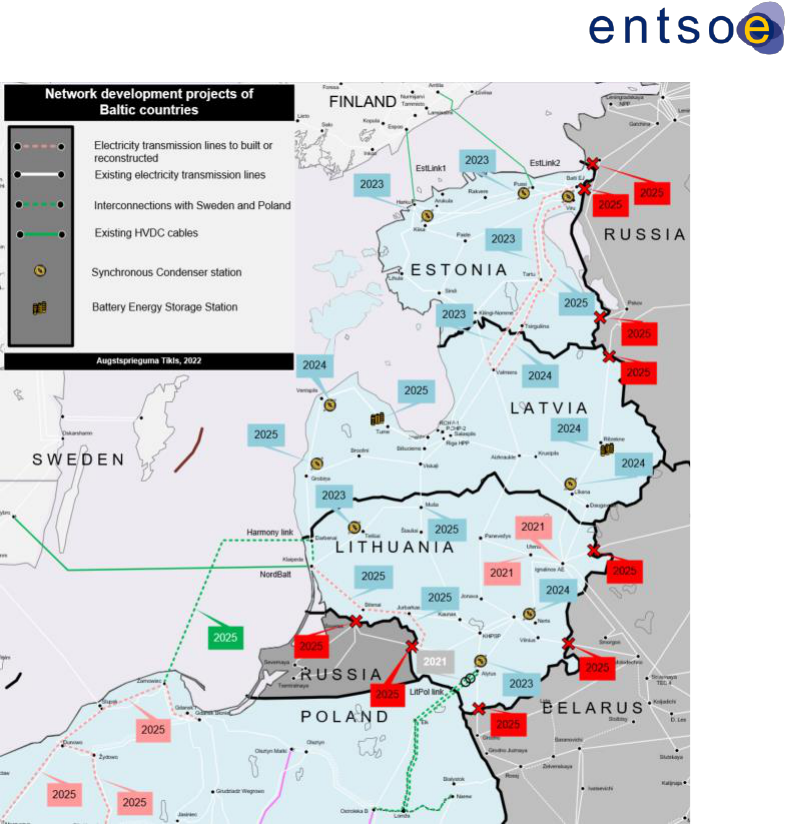
Regional Investment Plan 2022 – Baltic Sea
38
Figure 4-1: Topology of the investments for the Baltic States and Poland included in the Baltic
synchronisation project
The list of Projects of Common Interest has been developed on the basis of the European Parliament
and Council Regulation (EU) No.347/2013 of 17 April 2013, on guidelines for trans-European energy
infrastructure, and repealing Decision No 1364/2006/EC and amending Regulation (EC) No
713/2009, (EC) No 714/2009 and (EC) 715/2009. The Baltic synchronisation cluster is included in
the fifth PCI list with No. 4.8 under the corridor, which includes the Baltic Sea Region projects from
the Nordic countries, the Baltic States, Poland and Germany. Synchronisation Project 4.8 is titled
Integration and synchronisation of the Baltic States’ electricity system with the European network.
The inclusion of synchronisation-related investment items in the list of updated PCIs enhances the
importance of the synchronisation project for the whole Baltic Sea region and Europe as well. The
fifth PCI list includes only the most important and beneficial projects for the EU.
In 2021, AST, Litgrid and Elering signed a service contract with the consortium of transmission
system operators of continental Europe (CE TSOs) to prepare synchronisation studies that would
make recommendations on necessary upgrades to Baltic power systems.
The studies are expected to be finalized by the end of 2022. Prepared by the consortium, they are
crucial to the implementation and development of the Baltic power systems synchronisation with the
continental Europe power system. The results of the studies will identify equipment adjustments that

Regional Investment Plan 2022 – Baltic Sea
39
may be needed in the Baltic power system, as well as additional measures not previously identified,
to ensure that the system is ready for synchronization.
In total, 5 studies will be prepared, including a dynamic stability study and an oscillatory stability
study, both using a fully dynamic model of the Baltic region and continental Europe, as well as an
isolated operation study, a frequency stability assessment system (FSAS) study and a load-
frequency controller implementation (LFC) study in Baltic power systems. These synchronisation
studies are identified in Annex II of the CFI Agreement. The studies necessary for synchronisation
were determined by the ENTSO-E Regional Group Continental Europe (RGCE) to ensure that the
synchronous interconnection of the Baltic power system would contribute to the security and
reliability of continental Europe’s power systems. The RGCE also determined that these studies
were necessary to evaluate the Baltic power system’s ability to fulfil all of the technical requirements
in force in continental Europe. The studies and their deliverables are as follows:
1. Transient stability study – continuation of the transient stability assessment of Baltic power
systems after the synchronisation with the power systems of continental Europe with updated
dynamic models of the Baltic power systems.
2. Oscillatory study – small signal stability assessment of the Baltic power systems working
synchronously with the continental Europe systems. Assessment of oscillation modes both
within the area of 3 Baltic power systems and within the continental European systems.
Continuation of the previous studies with updated dynamic models of the 3 Baltic power
systems.
3. Island operation study – operational stability assessment of the Baltic power systems in the
event of an emergency disconnection from the IPS/UPS power system.
4. FSAS study – Concept development of frequency assessment and monitoring systems for
the 3 Baltic power systems when they are operating synchronously with those of continental
Europe or in the isolated island mode. Assessment of current best practices. Development
of system operation tools and data exchange principles.
5. LFC study – concept development of load-frequency control for the 3 Baltic power systems.
The synchronization studies have been designed by the consortium of continental Europe TSOs.
Only the consortium of CE TSOs has deep, specific and special knowledge of the operation of the
continental Europe power system; therefore, per ENTSO-E’s recommendation, the consortium of
CE TSOs is considered the source of competence for studies and the consultancy that will evaluate
the fulfilment of the requirements specified in the Catalogue of Measures of the CFI Agreement.
The rest of the projects and investments are on schedule; the Baltic States TSOs will have to move
quickly to meet the synchronization deadline.
Due to the war in Ukraine and tight relationships with NATO and the European Union, the Baltic
States’ urgent desynchronization from IPS/UPS is feasible even before 2025. One of the most
serious challenges still standing in the way of the synchronisation project’s implementation is clarity
regarding the operation and status of the Kaliningrad electrical enclave, which is part of the Russian
power system. Resolving this issue will require considerable political willpower and might influence
the technical outcomes and schedule of the synchronisation process.
Another important challenge in the TYNDP processes is the extension of the synchronously
connected European power system, particularly to the Ukrainian and Moldovan power systems,
following the model of the synchronization of the Baltic States. Future TYNDPs will analyse and
assess the impact of these challenges on a synchronously operated continental Europe.
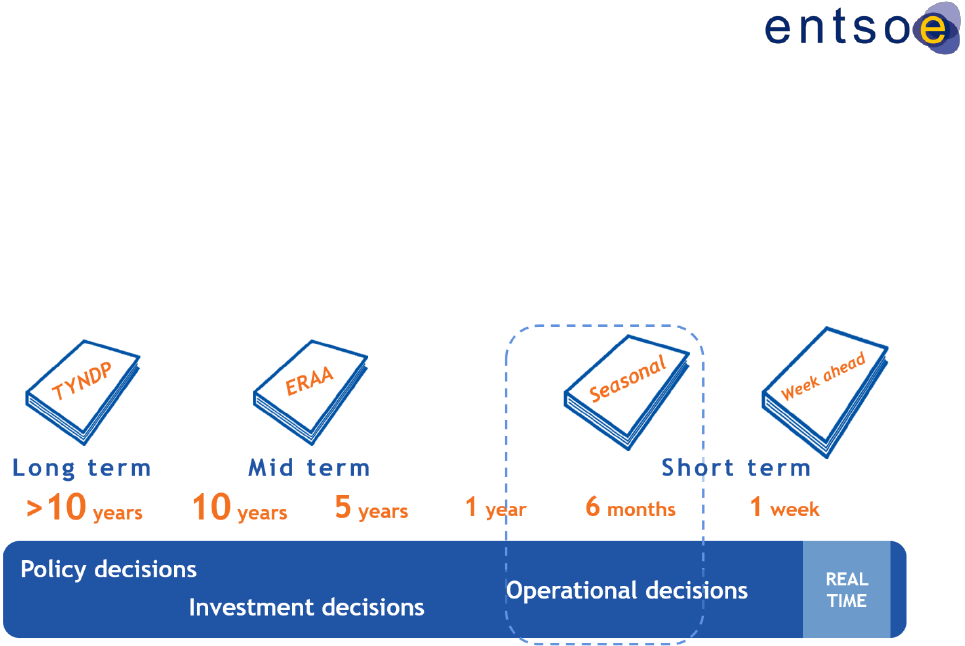
Regional Investment Plan 2022 – Baltic Sea
40
The Ukrainian and Moldovan power system synchronous connection project is described in Annex
3 of this document.
4.2 European Resource Adequacy Assessment (ERAA)
The electricity system’s resource adequacy is analysed for several time horizons, each with its own
objectives. The figure below shows time horizons and corresponding studies performed by ENTSO-
E and the TSO-s.
Figure 4-2: Electricity system studies
Mid-term system adequacy analysis is part of the European Resources Adequacy Assessment
(ERAA). One of the main objectives of this analysis is to understand which regions need a capacity
mechanism to ensure that there will be enough supply to cover the demand. Understanding the mid-
term adequacy situation (i.e., ten years from now) leaves time for the necessary investment
decisions and market arrangements to address any shortcomings.
The ERAA aims to provide stakeholders and policymakers with the data and insights necessary to
make informed, qualified decisions and promote the development of the European power system in
a reliable, sustainable and connected manner. The ERAA methodology is a leap forward from its
predecessor, the mid-term adequacy forecast (MAF), and complements national assessments with
a pan-European outlook. It is also coordinated and consistent with other timeframe studies such as
the ENTSO-E TYNDP and Seasonal Outlooks.
Figure 4-3 shows the results of ERAA 2021. If no additional steps are taken in the Baltic Sea area,
then in 2025 Lithuania has an increased risk of exceeding its reliability standard, which is set at 8
hours. In the case of exceeding reliability, the Member State must address the problem by first
removing any market obstructions and then, if necessary, offering state aid to suppliers to establish
a capacity mechanism.
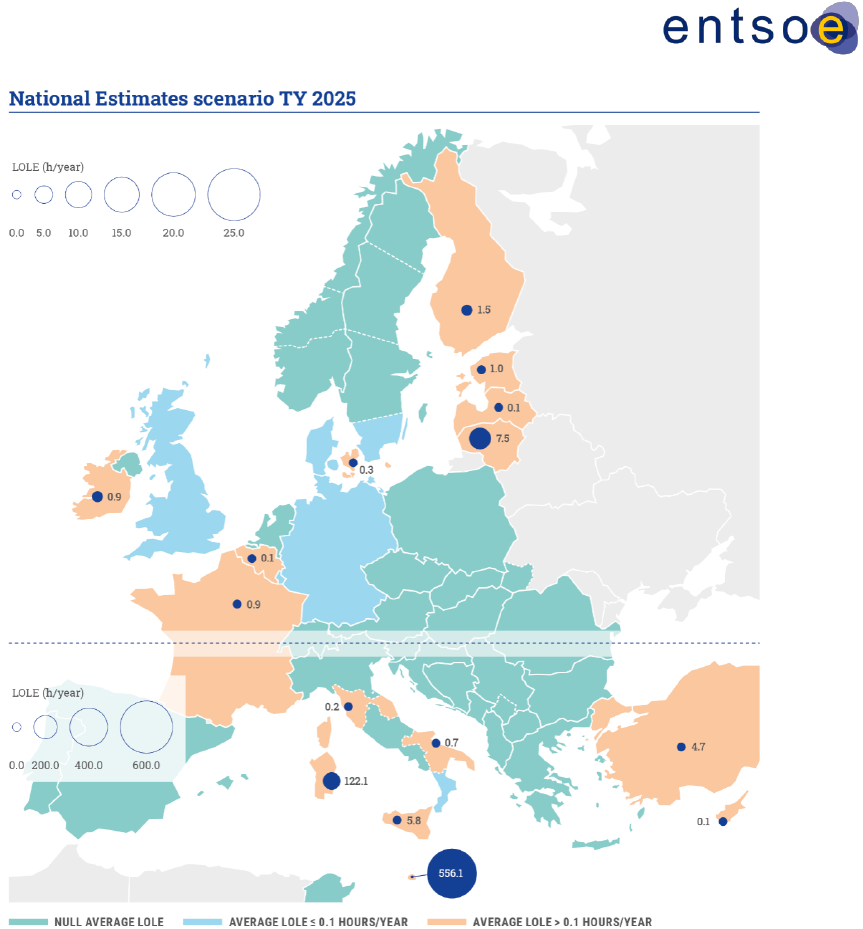
Regional Investment Plan 2022 – Baltic Sea
41
Figure 4-3: ERAA2021 LOLE values for 2025
In Figure 4-4, which is based on ERAA2021, it can be seen that system adequacy in the Baltic Sea
region is anticipated to have improved compared to 2025, with one exception. Denmark’s eastern
bidding zone is expected to experience on average 6.4 hours a year when demand cannot be fully
met. The LOLE value for Lithuania is predicted to decrease significantly between 2025 and 2030
and return to an acceptable level.
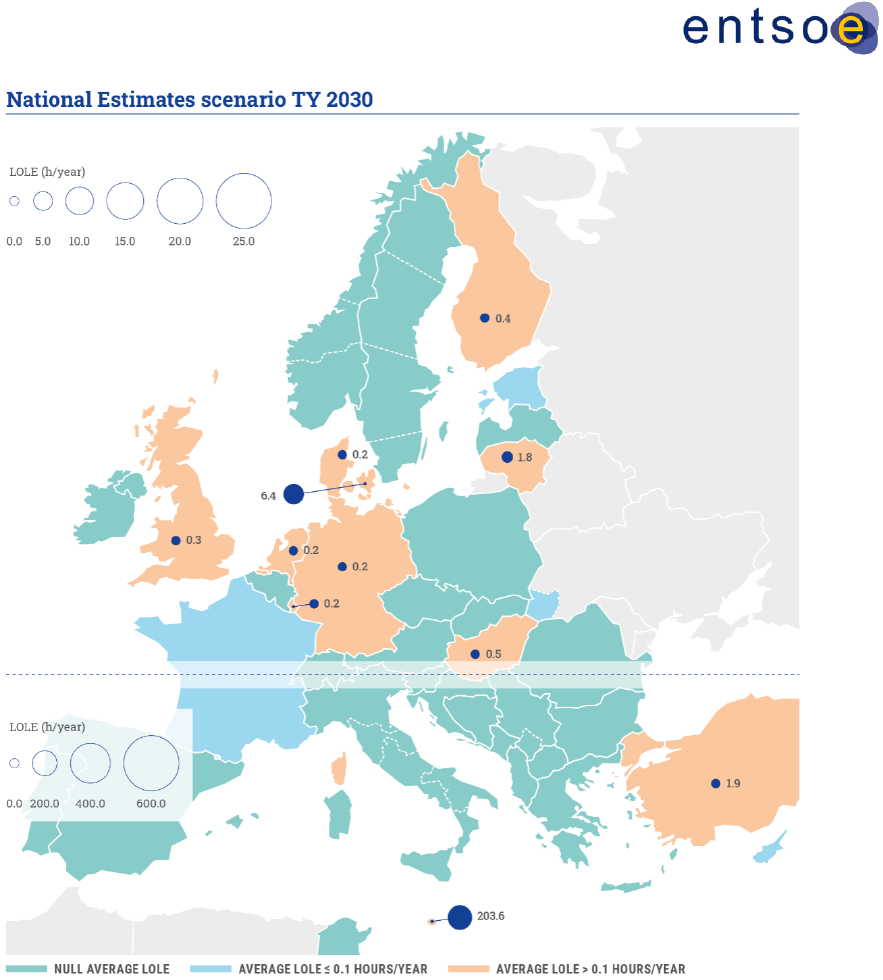
Regional Investment Plan 2022 – Baltic Sea
42
Figure 4-4: ERAA2021 LOLE values for 2030
An ERAA is performed every year, and these assessments are becoming more detailed and robust.
They are conducted collaboratively by ENTSO-E and the TSOs. The results and conclusions are
coordinated with the European Union Agency for the Cooperation of Energy Regulators (ACER).

Regional Investment Plan 2022 – Baltic Sea
43
4.3 Summer and Winter Outlooks
Seasonal outlooks, such as the Summer Outlook and Winter Outlook, analyse an upcoming season.
The objective of these studies is to provide insight into when the system can expect an increased
risk of loss of load and provide stakeholders with data and insights to make the best operational
decisions. Understanding when a region or bidding zone might experience unserved energy enables
the better optimisation of maintenance schedules for interconnectors and power plants or, if
necessary, the return of power plants from a mothballed state to the energy market.
In the Baltic Sea region, the Summer Outlook 2022 sees a risk of loss of load only for Denmark’s
eastern bidding zone. The other bidding zones are not expected to experience any unserved energy.
This risk to Denmark’s eastern bidding zone is now being watched closely. If necessary, the risk can
be mitigated by changing the planned maintenance schedule for an interconnector between South
Sweden and Denmark.
Figure 2-5: Adequacy situation in the summer of 2022
The scopes of the seasonal outlooks are somewhat flexible and can be extended to analyse the
most relevant risks to the European electricity system. Summer Outlook 2022 included a preliminary
analysis of a gas dependency. Since the Russian invasion of Ukraine on 24 February 2022, energy
imports from Russia have decreased significantly due to sanctions, embargos and other reasons.
Seasonal outlooks are being used to analyse different scenarios of the extent of this situation on
resource adequacy.
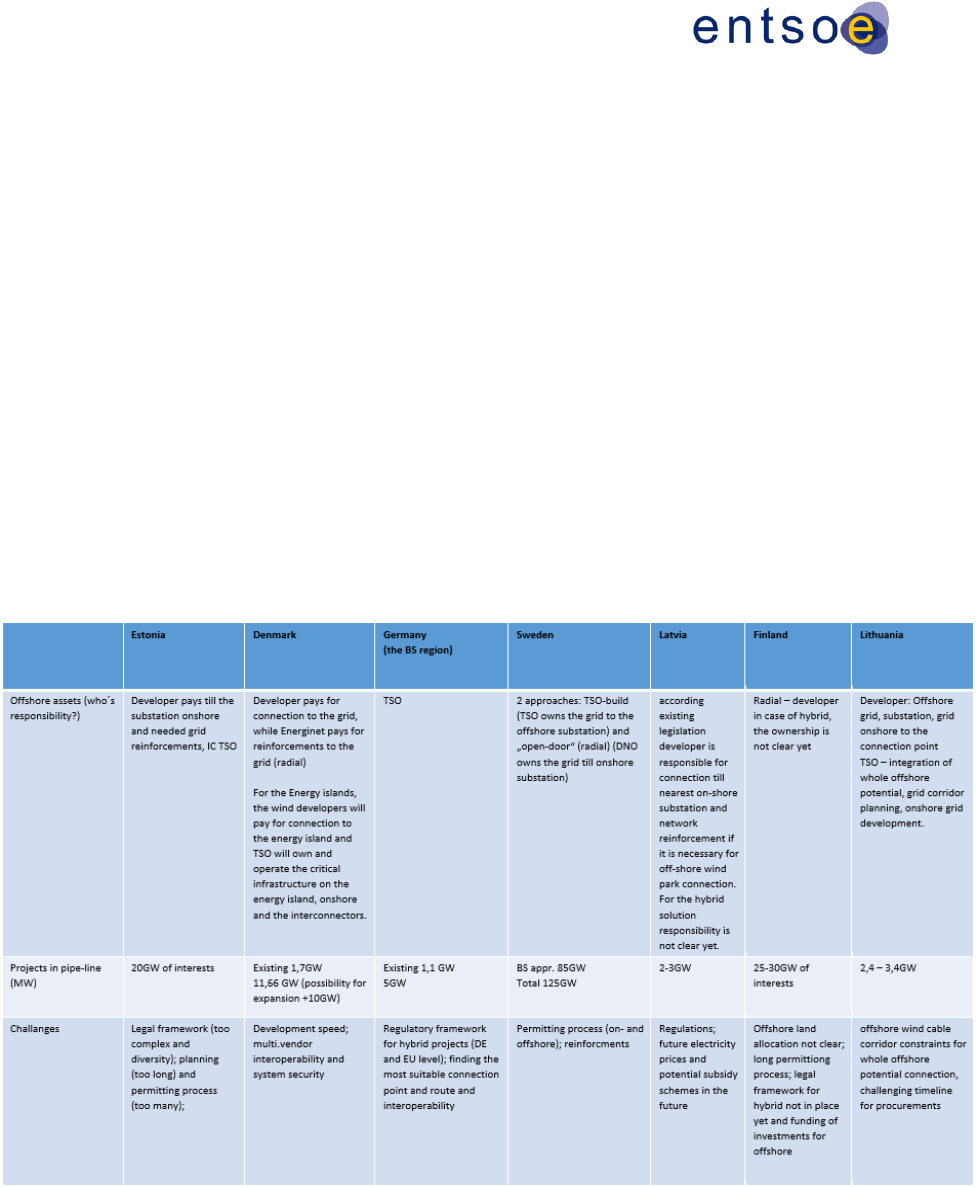
Regional Investment Plan 2022 – Baltic Sea
44
4.4 Baltic Offshore Grid Initiative – BOGI
The Baltic Offshore Grid Initiative (BOGI) working group contains members from 7 TSOs,
including Baltic Sea – Elering AS (EE), Fingrid Oyj (FI), Affärsverket Svenska Kraftnät (DE),
Energinet SOV (DK), 50Hertz Transmission GmbH (DE), AS Augstsprieguma tīkls (LV) and Litgrid
AB (LT). The Polish TSO, PSE Polskie Sieci Elektroenergetyczne, is currently not a member of
BOGI, but they are welcome to join. The aim of BOGI is to gather strategic inputs at the Baltic Sea
basin level for offshore grid development plans. For TSOs to be able to establish all of the
necessary technical preconditions for the offshore grid, a legal framework must be created or
established. Establishing an offshore grid is a multi-stage process, in which close cooperation
between the countries around the Baltic Sea plays a crucial role. To create a legal framework, it is
necessary to:
• jointly agree on the roadmap and principles for creating offshore connections;
• prepare mechanisms for costs and income allocation to overcome disproportional financing
needs from the offshore grid; and
• coordinate the planning and permits processes.
Offshore renewables targets and maritime spatial plans (MSPs) in the Baltic Sea are
playing a vital role in offshore grid development to achieve the EU’s and countries’ (or sea basins’)
climate and energy policy targets. The BOGI working group has made the first preliminary analysis
of the present state of play regarding the grid planning principles and challenges.
Table 4-1: Progress of offshore developments by the country
The main challenges are:
• missing legal frameworks or diverse approaches to legal frameworks in MSPs;
• the need for harmonized approaches to hybrid grid planning in the Baltic Sea region;
• a too lengthy permitting process for offshore grids (or in general); and

Regional Investment Plan 2022 – Baltic Sea
45
• the need for MSPs - based offshore RES targets to give TSOs a clear understanding of
what to develop.
5 FUTURE CHALLENGES IN THE REGION
5.1 Future infrastructure projects – gap analyses
The European power system began a major transformation in the last 10 years. One of the main
drivers for this transformation was the change in the power generation mix, that is, to replace
conventional power generation (thermal and partly nuclear decommissioning) with renewables (wind
and solar and water generation in several countries). This will lead to more climate-dependent power
generation, with a high fluctuating power infeed into the grid. As a result, an increased number of
flexible solutions will be needed. Part of the solution could be the increase of interconnector
capacities between countries and synchronous systems. Other drivers for grid development could
be system enlargement projects, such as the Baltic synchronisation and the synchronisation of
Ukraine and Moldova.
Two important tasks for the TYNDP package (including the RegIP) are 1) to identify future
transmission needs (i.e., 2030/40) and 2) to qualify relevant transmission projects for the next PCI
list. Both tasks have been carried out as part of the TYNDP process. In TYNDP 2016, ENTSO-E
began to develop future IoSNs. The aim is to show the future system needs for the transmission
system with a specific focus on climate goals, security of supply and socio-economic benefits. These
analyses will be done every second year and are based on the latest updated assumptions and
scenarios.
Figures 5-1 and 5-2 below display the identified capacity increase for the BS region’s borders in
2030 (left) and 2040 (right). LasGo-Link, the capacity increase project between Sweden and Latvia,
is not part of the national development plan in Sweden, and in February 2022, the Swedish TSO
rejected the grid connection inquiry from the promotor for the project.
Figure 5-1: Capacity need increases in 2030
Figure 5-2: Capacity need increases in 2040
To close the gaps between current and future system needs identified in the system needs analyses,
investment decisions for several transmission projects should be made in this or subsequent
decades. The next section describes some cross-border transmission projects in the Baltic Sea
region. These project development activities will help to close the gaps.

Regional Investment Plan 2022 – Baltic Sea
46
Detailed analysis per relevant borders
The theoretical identification of needs for increased capacity, which is based on current assumptions,
suggests possible areas where system development will be necessary.
Capacity increases on the Sweden-German border
The following projects are foreseen to close the gap between current and future system needs:
• Hansa PowerBridge I (Germany-Sweden): The planned capacity is 700 MW. The
project could be realized by approximately 2026.
• Hansa PowerBridge II (Germany-Sweden): The planned capacity is 700 MW. The
project could be realized by approximately 2035.
Both projects are included in TYNDP 2022 and will get a CBA assessment.
Capacity increases on the Norway-German border
The Nordlink project (Norway-Germany), new, was included in previous system needs analyses and
investment decisions. Its capacity is 1400 MW. The project was finalized in 2020.
Capacity increases on the Norway-German border
The Nord Sea Link project (Norway-UK), designed to close the gap between current and future
system needs, was included in previous system needs analyses and investment decisions. Its
capacity is 1400 MW. The project was finalized in 2021.
Capacity increases on the Sweden-Poland border
The identified capacity increases of 500 MW in the 2030 scenario and 1000 MW in the 2040 scenario
are subject to further discussion and analysis since there is no existing agreement or planned project
at this stage.
Capacity increases on the Lithuania-Poland border
The identified capacity increase of 700 MW in the 2030 scenario is subject to the implementation of
the Harmony Link in the Baltic synchronization project.
Capacity increases on the Lithuania-Sweden border
The identified capacity increase of 600 MW in the 2030 scenario is subject to further discussion and
analysis since there is no existing agreement or planned project at this stage.
Capacity increases on the Lithuania-Latvia border
The identified capacity increase of 500 MW in the 2040 scenario is subject to further discussion and
analysis since there is no existing agreement or planned project at this stage.
Capacity increases on the Finland-Sweden border
The TYNDP projects Aurora line (FI-SE1), Aurora line 2 (FI-SE1), and Fenno-Skan 1 renewal (FI-
SE3) are closing the gap between current and future system needs between Finland and Sweden.
Capacity increases on the Finland-Estonia border
The TYNDP Estlink 3 (FI-EE) project is closing the gap between current and future system needs
between Finland and Estonia.
Capacity increases on the Finland-Norway border

Regional Investment Plan 2022 – Baltic Sea
47
A 500 MW capacity increase need between Finland and Norway was identified in the IoSN. However,
new connections between Finland and Norway were not investigated in the TYNDP2022 process
since the investment cost of such connections is expected to be very high, compared to the benefits.
It should be noted and emphasized that, at present, all of the abovementioned projects are only
possible grid development options to fully or partly cover the future identified capacity increases and
system needs. They are all subject to change based on the assumptions in future scenarios. The
future capacity increases which are not covered by any projects in TYNDP2022 will have to be
bilaterally analysed by the TSOs. After completing such analyses, the TSOs may suggest projects
for inclusion in future TYNDPs.
5.2 Nordic Grid Development Perspective 2021
The Nordic countries have a long-term history of cooperation in energy matters. The Nordic
electricity system is highly interconnected, and the countries are frontrunners in such areas as
renewables and sector coupling. Therefore, they have an excellent foundation for addressing new
challenges together – for example, in the Nordic Grid Development Perspective (NGDP) report.
NGDP is intended to function as a complementary bridge between the national planning
processes and the ENTSO-E TYNDP. NGDP2021 communicated a common Nordic view on the
development of the future power system in a climate-neutral Nordic society and investigated the
future system needs. Furthermore, the report presented a Nordic view on selected focus areas:
offshore wind, north-south power transfer and resource adequacy in the future system. In addition,
it updated the status of the five Nordic corridors of interest from the previous NGDP2019. The NGDP
report is published every second year, and the latest, NGDP2021, is available here:
ngdp_2021_final_report_fixed3.pdf (fingrid.fi). The key findings of NGDP2021 are as follows.
Climate-neutral societies need more electricity - Significant investments in the grid
and cross-border connections are needed.
Electricity consumption and production are expected to increase significantly in the future.
The Climate Neutral Nordics scenario in NGDP2021 assumes that the annual Nordic electricity
consumption will increase from the current approximately 400 TWh to 655 TWh by 2040. The
scenario also assumes that renewables generation capacity will more than double from 85 GW to
approximately 190 GW. Changes in the energy system are occurring faster than ever.
The Climate Neutral Nordics scenario also shows that the electricity transfer needs in the
Nordic system are increasing. Furthermore, the existing flow patterns might change significantly in
the future. As an example, the future dominant flow direction might be from bidding zone SE2 to SE1
rather than in the opposite direction. The results of this report indicate that there is a need to reinforce
the Nordic grid, and large investments are needed to increase the grid capacities in several Nordic
corridors. In many cases, the installation of new lines or cables is needed. However, there are also
ways to increase capacity without traditional grid investments and methods for using the existing
transmission more effectively (e.g. utilizing flexibility). The needs identified in the Climate Neutral
Nordics scenario are important inputs for more detailed planning processes.
The Nordics are an excellent place for future investments
The Nordic electricity system is already a strong system, with good possibilities for
connecting generation and consumption. In addition, the Nordic TSOs are making significant
investments in the power grid to be able to make the connections between electricity production and
consumption that will be required in the climate-neutral society of the future.
This means that there will be a considerable amount of competitively priced and green
electricity available in the Nordics in the future. The Climate Neutral scenario indicates an electricity

Regional Investment Plan 2022 – Baltic Sea
48
surplus in the Nordics in the future, with average power prices lower than the prices in continental
Europe. This, combined with a strong power grid, makes the Nordics an excellent location for power-
intensive investments.
The future system is more volatile - flexibility is needed and will become increasingly
profitable
The analyses show that system volatility is increasing. This applies to all aspects of the power
system – flows, balances, prices, adequacy questions, etc. As volatility increases, so does the need
for flexibility throughout the power system. Furthermore, electrification and the energy transition from
fossil fuels are increasing the need for flexibility.
Available flexibility will assist in the optimal development and operation of the future system.
Flexibility resources, such as demand side response, P2X, storage, and electric vehicles will become
increasingly important to even out the variations in the system and are needed to reduce volatility.
Due to wider variations in power prices, it is expected that there will be profitable ways to operate
these resources in the future system. However, conventional generation and, especially, regulated
hydropower will remain important resources in the future system.
The future system is more complex and as new characteristics - new solutions and
collaboration throughout the whole energy system are needed
The future system is becoming more complex and different sectors are becoming more
interlinked. Furthermore, the future system is expected to contain large amounts of new resources
and technologies such as offshore wind and P2X. The entire energy system should operate together
seamlessly with the new resources, and this increases the need for collaboration between different
actors. The grid, consumption, production, flexibility and other resources should be developed
together.
In addition, the characteristics of the future system will differ significantly from the current
system. The future system has high amounts of converters, lower inertia and high and volatile
transfer needs. New solutions are needed to tackle these challenges optimally. These challenges
and solutions are discussed more thoroughly in the Nordic Solutions 2022 report that is available
here: Solutions Report 2022 with Nordic TSO strategy is published. Updated 14 March. - Fingrid
Regional grid plans and studies will be updated and developed
The NGDP will be updated every second year and constitutes only one of many different
regional grid development initiatives. The next NGDP is scheduled to be published in 2023. The
Nordic TSOs have also prepared a common Nordic strategy, which is to be published with the
Solutions report in 2022. In addition to addressing system planning aspects, the strategy provides a
broader view of the issues, including markets and system operation. Furthermore, the Nordic TSOs
have identified a need for developing mid-term collaborations in both operations and planning to
complement their long-term collaborations.
In the European context, ENTSO-E publishes the European TYNDP every second year. A
regional Baltic Sea investment plan is published as a part of the TYNDP. In addition, each TSO
continuously updates their national grid development plans and publishes long-term market and grid
analyses. These reports focus more closely on national aspects.
It is important that the Nordic planning and collaboration processes are transparent and that
stakeholders are involved at an early stage. Thus, the involvement of stakeholders through
workshops and consultations will continue to be an important part of the Nordic grid planning and
other forms of collaboration.
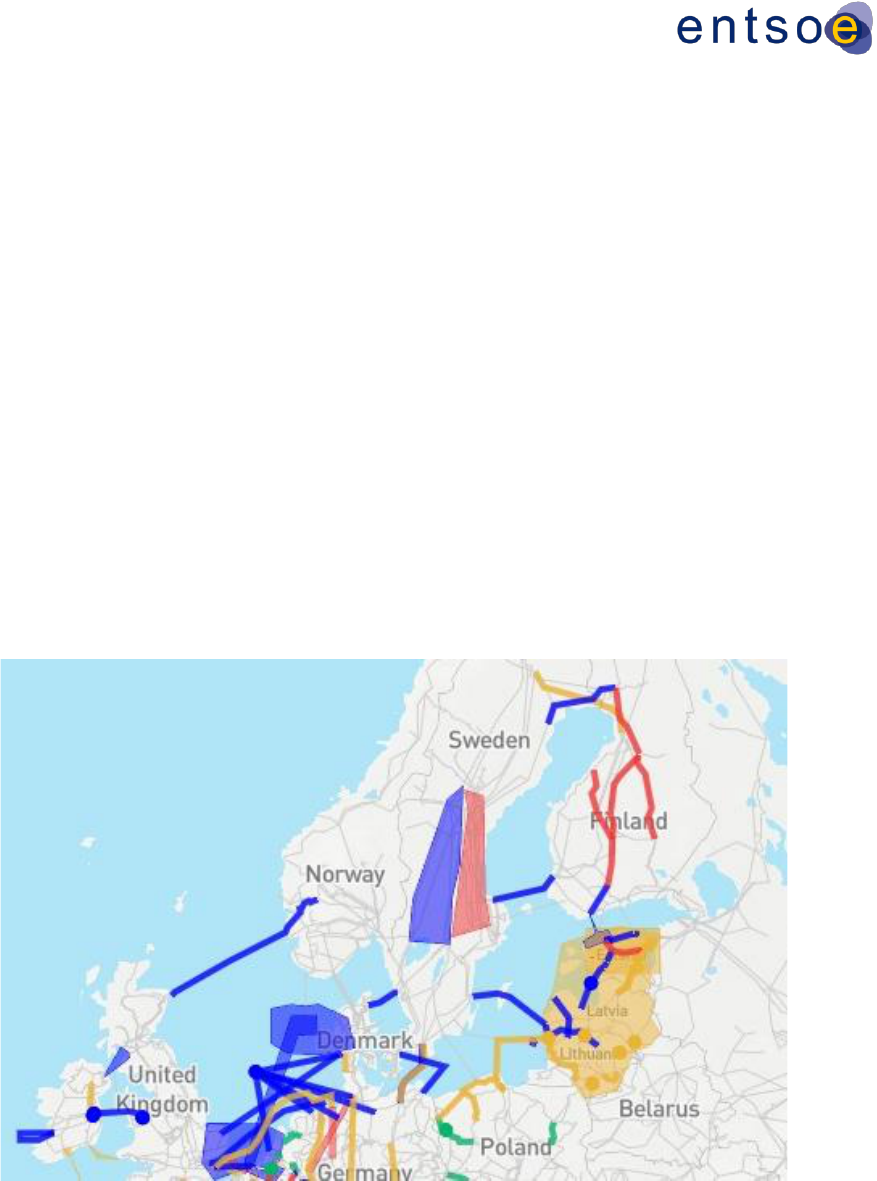
Regional Investment Plan 2022 – Baltic Sea
49
APPENDICES
1. Pan-European projects
The following projects were collected during the project calls and represent the most
important projects for the region. To be included in the analysis, a project needs to meet several
criteria. These criteria are described in the ENTSO-E practical implementation of the guidelines for
inclusion in the TYNDP 2022 for pan-European importance.
The map below shows all of the project applicants submitted by project promoters during the
TYNDP 2022 first call for projects of pan-European significance. In the final version of this document
– after the second round of project submission and the public consultation phase – the map will be
updated to show the approved projects that relate to TYNDP 2022. Following the CBA guidelines,
the projects are divided into four states:
• In permitting
• Planned but not permitting
• Under consideration
• Under construction
Depending on the defined status above of a project, it will be assessed according to the
CBA approved by ENTSO-E, ACER and European Commission.
Figure A-1-1 Projects submitted to the TYNDP 2022
The blue interconnector in Figure A-1-1 between Sweden and Latvia, LasGo-Link, is not part of the
national development plan in Sweden. The Swedish TSO has previously rejected a grid connection
inquiry for the project.
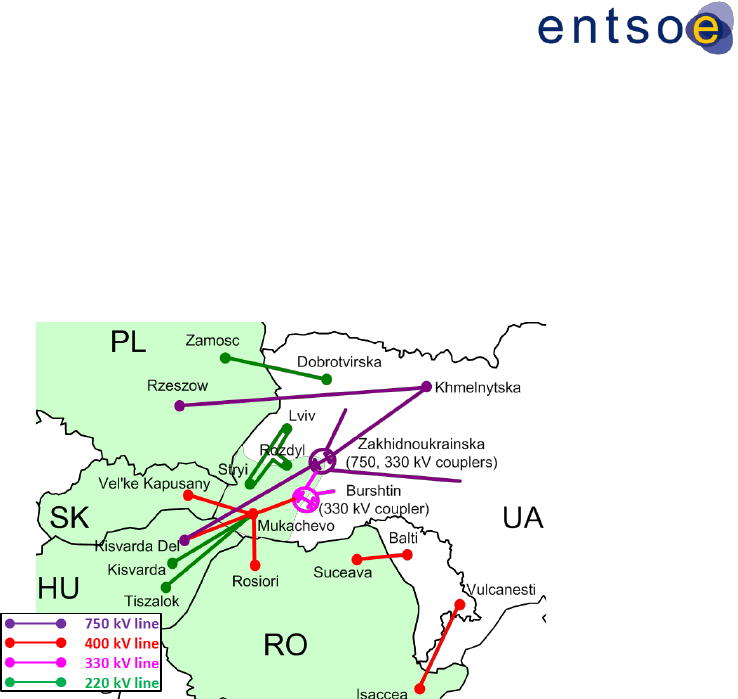
Regional Investment Plan 2022 – Baltic Sea
50
2. The Ukrainian and Moldovan power system synchronous connection
The synchronous connection of the Ukrainian and Moldovan power system to the continental
Europe power system is one of the most important future challenges for the CCE region. Only one
part of the IPS of Ukraine, the so-called Burshtynska TPP Island, was synchronously operated with
Slovakia, Hungary and Romania with 220, 400 kV and 750 kV transmission lines. The ‘Island’
includes Burshtynska TPP, Kaluska CHPP and Tereblia-Rikska HPP, which have a total installed
capacity of 2,530 MW, maximum export capabilities of up to 650 MW, an infrastructure of 220–750
kV and distribution networks of electricity suppliers in the Carpathian region.
Figure A-2-1 Schematic overview of the Ukrainian and Moldovan power system interconnectors with
the surrounding ENTSO-E TSOs
The integration of the whole IPS of Ukraine into the continental European power system was
one of the Ukrainian TSO’s key goals in power grid development. It is also one of the most important
elements for the energy security, reliability and balanced performance of the IPS of Ukraine. It will
allow the effective use of energy resources and a significant increase in power exchange capabilities.
Integration of the IPS of Ukraine into ENTSO-E is stipulated in the EU-Ukraine Association
Agreement. Preparations for the interconnection of the Ukrainian and Moldovan power systems to
the continental European power system started in March 2006, when the TSOs of Ukraine and
Moldova filed a request for synchronous interconnection to the system of UCTE, now ENTSO-E.
A consortium of ENTSO-E members conducted a feasibility study, The synchronous
interconnection of the Ukrainian and Moldovan power systems to ENTSO-E continental Europe
power system, which was completed in January 2016.
The overall objectives of the feasibility study were
• to investigate the possibility of operating the Ukrainian and Moldovan power systems in parallel
with those in the continental European synchronous area, respecting their technical
operational standards; and
• to investigate the degree of implementation of ENTSO-E’s technical operational standards in
the Ukrainian and Moldovan power systems.
The feasibility study presented appropriate recommendations to overcome the main technical,
organisational and possible legal obstacles and supported the work of various appropriate bodies,
including ENTSO-E, to decide and agree on the needed measures. The main conclusions of the
feasibility study are summarised below.

Regional Investment Plan 2022 – Baltic Sea
51
• From the perspective of static analysis, the synchronous connection of the Ukrainian and
Moldovan power systems to the continental part of ENTSO-E is feasible with the existing and
planned infrastructure.
• Dynamic analysis shows that the connection will not be feasible without the application of
proper countermeasures due to the inter-area instability risks identified in the interconnected
model. The source of the instability is insufficient damping for low-frequency oscillations at
large generators in Ukraine.
• The inter-area stability could be improved if one of the proposed countermeasures were
applied. The solutions to be adopted would have to be verified by the manufacturers of the
existing control systems in power plants in Ukraine and Moldova, particularly in the case of
nuclear power plants.
• Only after such revision of the proposed measures and on-site testing of selected exciters
and governors can the final evaluation of the efficiency of the countermeasures and their
influence on the small-signal inter-area stability of the interconnected systems be carried out.
• The data and analyses relating to operational issues indicate that the power systems of
Ukraine and Moldova are partially prepared for synchronous operation with the continental
European system under the Operation Handbook guidelines of ENTSO-E. The main issues
that will have to be dealt with to reach the expected level of compliance are connected to
frequency regulation, real-time operations and special protection systems.
• The European energy legal system, and the Third Energy Package in particular, should be
fully implemented in both Ukraine and Moldova. The information received from UA/MD
revealed that the energy legal systems in place in Moldova and Ukraine are not currently fully
compliant with the system applicable in the ENTSO-E countries, although both systems are
moving in the right direction.
In June 2017, agreements on the conditions of the future interconnection of the power
systems of Ukraine/Moldova with the power system of continental Europe were signed. These
agreements contain catalogues of measures to be implemented by Ukraine and Moldova. One of
the actions is to perform additional studies to investigate, in detail, the needed technical measures
to ensure system stability.
The additional studies began in April 2020 and were completed in December 2021. They
analysed the possibility of synchronously connecting the power systems of Ukraine, Moldova and
continental Europe in the present situation (without development projects). The technical measures
to ensure system stability were determined based on dynamics models that took into consideration
the results of recent unit tests performed in Ukraine and Moldova.
The main conclusions of the study were:
• Steady-state analyses showed that the synchronous connection of Ukraine and Moldova to
the continental part of ENTSO-E was feasible without the need for reinforcements or
additional infrastructure.
• Dynamic analysis identified one threat to the safe operation of the connected systems: the
insufficient damping of low-frequency oscillations with a large participation of generators in
Ukraine. It was found that these threats occur in off-peak scenarios for power exports from
Ukraine and Moldova. Under certain conditions, the 5% inter-area oscillation damping limit
would not be met. Countermeasures necessary to improve the inter-area stability of Ukraine
and Moldova in the interconnected power systems were analyzed. This analysis assessed
the effectiveness of using existing solutions to dampen low-frequency oscillations in the
Ukrainian system and investigated new potential countermeasures.

Regional Investment Plan 2022 – Baltic Sea
52
After the results were obtained, the solution proposed for improving the damping of the inter-
area oscillations was to retune selected dual input power system stabilizers (M1). The selection of
the stabilizers should be based on the damping improvement achieved by retuning. Therefore,
retuning should apply to units that have generators which contribute significantly to inter-area
oscillations and do not have properly tuned power system stabilizers. It was also found that limiting
retuning to generators with rated power over 50 MVA (M1**) was feasible and only slightly decreased
effectiveness.
Based on the study, the retuning should be supplemented with additional measures selected
from the following:
• adding standalone stabilizers to the 1111 MVA nuclear units equipped with REM700
Brushless excitation systems (M2),
• AVR retuning on all generators of the nuclear units (M3),
• installation of STATCOMs with a POD using frequency signal or another power electronic
device that could provide equivalent damping (M4),
• frequency feedback retuning on generators at Zaporizka NPP (M5),
• frequency feedback retuning and AVR gain reduction on generators at Zaporizka NPP (M6).
Each of these additional measures would ensure a significant and sufficient improvement of
the damping of the inter-area oscillations involving Ukraine and Moldova (except for M1** and M5,
for which the calculated damping may be slightly below 5 % for high power exports in CESA). The
solution adopted may be a mix of suggested measures. After applying the proposed
countermeasures, no inter-area stability constraints for maximum power exports from Ukraine and
Moldova will be obtained in the load flow calculations.
On 27 and 28 February 2022, after isolated operational tests took place, the continental
Europe TSOs received a request from Ukrenergo (the Ukrainian TSO) and Moldelectrica (the
Moldovan TSO) for an emergency synchronisation with the continental Europe power system, which
was supported by the EU Energy Ministers. The continental Europe TSOs committed to responding
positively to Ukrenergo’s request and started analysing the conditions for an emergency
synchronisation while maintaining the safety of the continental Europe power system. A task force
was created under the ENTSO-E System Operation Committee – Regional Group Continental
Europe to cover the following topics: protection and dynamic stability, operations and markets, legal
and regulatory, and information technology including cybersecurity.
The task force (TF) determined the minimum requirements, assessed the risks of
synchronization and defined the necessary actions to be implemented to mitigate the identified risks.
Exceptional actions were implemented with the support of concerned stakeholders and authorities.
On 11 March, continental Europe TSOs concluded that the conditions for an emergency
synchronisation were met and completed the emergency synchronisation on 16 March. Throughout
the process, the continental Europe TSOs received support from the European Commission, the
Member States and the Regulatory Authorities. Comprehensive 24/7 monitoring of the situation has
been instituted, and further appropriate measures have been planned.
Currently, there are no commercial exchanges between UA/MD and continental Europe, but
the transfer capacity will be increased gradually after the implementation of some necessary
measures.

Regional Investment Plan 2022 – Baltic Sea
53
Acknowledgements
ENTSO-E would like to thank all the experts involved in the Ten-Year Network Development Plan
2022 for their commitment and enthusiasm in building this unique coordinated pan-European plan.
In particular, ENTSO-E would like to thank the following experts who contributed to this report.
Authors
Getlyn Allikivi - Elering
Ramunas Bikulcius – Litgrid
Michael Heit - 50 Hertz
Anne Hommelgaard Falcon – Energinet
Jarmo Ling – Elering
Arne Egil Pettersen – Statnett
Janne Seppanen – Fingrid
Ebrahim Shayesteh – Svenska Kraftnat
Oleg Tsernobrovkin – Elering
Andrzej Tymorek – PSE Operator
Ansis Zbanovs – AS Augstsprieguma tikls

ENTSO-E . Rue de Spa 8 . 1000 Brussels . Belgium
